After 1.5 years of working holiday in New Zealand where I had the best time of my life, I decided to try a 2nd working holiday in Australia!
What is a working holiday scheme? It is an agreement that allows the participants from 1 country to live in the other country longer than they are allowed on a tourist visa, and with working rights. As the name implies, it can be for work or/and holiday purposes. In my opinion, it is a great opportunity for travellers who want to earn money as they travel.
For Singaporeans, there are 2 destinations available for a working holiday – New Zealand and Australia. (Some countries like Japan have agreements with over 20 countries!) A working holiday in Australia for Singaporeans requires a Work and Holiday visa (subclass 762). This visa is open to Singaporean youths from 18 – 30 years old who have been through at least 2 years of tertiary education. It is valid for 1 year, with the possibility of extensions up to a 2nd and 3rd year.
My goal for creating this guide is to provide information and inspiration from my own experiences for those who are considering or preparing to embark on a working holiday to Australia. Take note that my experience is just one of the many possibilities for a working holiday in Australia – specifically living and working in a major city.
In this guide, I will share an chronological account of my journey from application, pre-departure to the time I spent there and a few tips to help you🙂
Application
The Work and Holiday visa (subclass 462) has a quota of 500 spots for Singaporeans in a program year (1 July – 30 June). I believe it is not competitive to get the visa as I could get it even though I applied in late February. This is unlike the case in other countries where the spots get snapped up at the moment when application opens. That is why I recommend more Singaporeans to grab this opportunity!
For the online application, there are some documents that you have to upload such as a bank statement that shows AUD5000 in funds and proof of your tertiary education. I had to go down to my university to get copy of my degree certified.
After submitting the application, I was requested to go for a health examination (including an X-ray) at a certified clinic and biometric registration at VFS Global. A few weeks after I completed those, I was asked to submit more evidence of my tertiary education i.e. degree transcripts.
Be prepared for the costs of application. The application fee alone costs a whopping AUD635 (SGD533)! The health examination at SATA CommHealth and biometric registration costed me a further SGD229 and SGD37 respectively. Well… it may not be that bad considering how quickly you can earn that amount back if you start working in Australia.
Alas, I received good news about the approval of my application on 2 April. The wait took a little over 1 month from the point when I submitted the application on 21 February. This includes the time it took to book my appointments.
Pre-departure
Make a plan
Clarify your goal
The first thing you want to do is to clarify your main goal for a working holiday in Australia. With the huge size of Australia, it offers a variety of options to suit different goals.
In Australia, I have met working holiday-ers of different nationalities and backgrounds. Some of them are students on a gap year who want to get life experiences. Some are working adults who want to earn more money. Some are hopeful migrants whose goal is to get permanent residence in Australia.
As I have previously attained my goal of finding healing and inspiration from a drastically different way of life in New Zealand, my goal this time in Australia was mainly to save up money while experiencing life in a different country.
Depending on what your goal is, it will influence your decisions about what to do, when to go, where to land, etc.
What to do
Unlike a work visa where you have to be offered a job beforehand to have the rights to stay long-term, a working holiday visa gives you those rights before you find a job. However, there is no rule that you must work. That means that you can do other things than working.
Work
The Work and Holiday visa legally permits you to work in Australia for no longer than 6 months under an employer, with some exceptions.
Getting a job in your professional field is unlikely because employers would not want to hire someone for such a short period of time, let alone a foreigner. There are exceptions I have met are such as nurses who managed to find relevant work in aged care facilities. Otherwise, you will likely be doing short-term work in sectors like tourism, hospitality and agriculture.
People generally do not go on a working holiday to advance their career. Rather, they take a career break to do a working holiday. Work contributes to one of the following goals:
- To fund their travel adventures across Australia
- To experience a different culture and lifestyle (especially those who experienced Asian work culture or burnout)
- To earn much money (especially those from countries with low or stagnating wages) as Australia has the world’s highest minimum wage at AUD24.10/hr
- To try their luck at gaining sponsorship for long-term work and eventually permanent residence
From the Australian government’s point of view, they prefer working holiday-ers to fill up labour shortage in the regional areas. That is why they grant 2nd and 3rd year extension to those who work 88 days and 6 months respectively in regional areas. I met many working holiday-ers who are on their 2nd or 3rd year. If you want to extend your visa, you have to actively look for these work.
Volunteer
If there are specific fields where you want to gain experiences in, you might want to volunteer.
One of the volunteering opportunities is WWOOF (World Wide Opportunities on Organic Farm), whereby travellers volunteer on farms in exchange for accommodation and meals. This concept has existed among the international traveller community for awhile. In my opinion, this would be an interesting experience for any Singaporean who is unfamiliar with rural lifestyles or agriculture. If you do disaster relief work, it counts towards visa extension.
I have written a post about my numerous WWOOF experiences in New Zealand. It is a shame that I did get to try it in Australia though.
Study
The visa also allows you to study for up to 4 months. Though this is not applicable for Singaporeans, I know of many working holiday-ers from non English-speaking countries who go to language school to brush up their English. You might be able to find short-term courses in vocational school to learn some specialised skills.
When to go
Upon obtaining the visa, you can choose any date within the next 1 year to enter Australia.
You may want to consider the season when you arrive. In the Southern hemisphere, the seasons are the other way round so December – February are the summer months. Summer is considered the tourist peak season, when people flock to the beautiful beaches that Australia is known for. There is plenty of information online on the different types of work during different seasons, so do keep an eye out for it.
Where to land
The next question is where to land first. If you do not already know where you want to go to, it can be a big question. Sydney? Melbourne? Perth? These are the popular Australian cities that Singaporeans often hear about.
You can do your own research to see where suits you in terms of specific criteria like climate. For example, if you prefer the cold you might want to be based south. Victoria, a Southeastern state, has a temperate climate. Queensland, a Northeastern state, has a sub-tropical climate.
If you are still unsure, that is fine because the place where you land is not necessarily where you will settle down. In fact, it is common for working holiday-ers to relocate.
Flights
That being said, you can choose based on flights. The most frequent (and fairly cheap) flights are from Singapore to Sydney. Alternatively, you can fly from Singapore to Perth which takes merely about 5 hours.
However, it may not be very economical to relocate too far. If there is one thing I underestimated, it is the size of Australia. It is more like a continent than a country! It helps to have a rough idea of which area you prefer to move around within.
West Coast vs East Coast
Australia can be divided into the West (where Perth is) and East Coast (where Sydney and Melbourne are). The West Coast has fewer people and a more laid back culture compared to the East Coast. But is it also said that there are more economic opportunities in the East Coast.
Since we landed on the East Coast to visit my relatives in Sydney, we eventually relocated to Brisbane that is a more northern part of the coast.
Where to stay
Many working holidayers book accommodation at a backpacker hostel or Airbnb for a few days or weeks upon arrival. In the meantime, they can look for a place to rent for the long term. Renting is the preferred option in the long run as hostels could be noisy and lacking privacy. Alternatively, you have the option of staying at a local’s place for free through volunteering.
Consider the fact that the place where you choose to stay will determine the first connections you make. Backpackers can give you information that is more relevant to a working holiday (I had a friend who got to know nationwide job opportunities from the backpackers he met at hostels) while locals can give you more information that is more localised and not always relevant to a backpacker.
What to pack
The sunshine in Australia is really harsh. So, bring UV protection items like sunscreen!
You can find many suggested packing lists online based on when and where you are going. The one thing I regretted bringing was my thick down jacket because it turned out to be too much for the mild winter of Brisbane (and it took up space in my luggage!!).
There is no need to worry too much about bringing everything you need because you can buy common household items and clothes easily at a cheap nationwide retailer called Kmart.
Administrative matters
Money
Bringing too much cash on hand is usually a safety concern for travel. Thankfully I have a multi-currency account with DBS which allows me to use my local debit card for payment in Australia without transactional fees. I could exchange a sum from SGD to AUD on the DBS digibank app anytime. After you create a local bank account and get an EFTPOS card in Australia, you can start to use that instead.
Like Singapore, Australia is quickly turning into a cashless society. (Although there is a small movement against it) You should be able to get by without cash at all if you are not in somewhere too remote. In my experience, cash is useful when you make transactions on facebook marketplace or when you want to avoid card surcharge at some shops.
This is for later but I also find it useful to open a Wise account which can also serve as an Australian bank account that local transfers can be made to. I used it when I left the country and lost access to my local bank account but needed to provide a bank account for the tax refund and Super withdrawal to be deposited.
Insurance
You are supposed to buy insurance but I did not. Please do not follow my example. At your own risk!
Arrival
Administrative matters
Get a phone number
First thing to do at the airport – buy a prepaid SIM card to get your Australian phone number and data package. There are countless of telco booths that can help you get started if you are not sure how. The popular telco options are Vodafone and Telstra (which is known for better coverage in regional areas).
An Australian phone number is essential for all the other things later like opening a bank account and applying for jobs.
Open a bank account
Surprisingly, it is really easy to open a bank account. I created an ANZ Plus account with the ANZ Plus app, literally at my fingertips. An appointment at a bank branch was not required at all. You can verify your identity simply by using your phone camera to snap a selfie and your passport. This is not the case with other banks.
After opening the account, they will send you your EFTPOS card by mail.
Apply for a TFN number
A Tax File Number (TFN) is necessary when you fill in the details before starting a job. Otherwise, you will be taxed at the highest rate. Upon landing in Australia, you can apply for a TFN online. You need to provide a mailing address for them to post to. I used the address of my relatives who reside in Australia.
As it can take up to 28 days for the mail to arrive, it might not be feasible if you are going to stay short-term in a hostel or Airbnb. I have heard of people who called up the Australian Tax Office (ATO) 1 week after their application to ask for their TFN directly. Hence, you do not have to wait until the mail arrives.
Apply for a Super
Superannuation, also known as “Super”, is a retirement fund that a part of your income goes into, like CPF in Singapore. Similarly, you will be asked to provide the details of your chosen Super fund before starting a job.
There are many options of Super funds which you can choose to sign up with, depending on criteria like performance and what they invest in. Without too much research into this, I signed up with the Australian Ethical Fund.
Settling down (1st month)
After I landed in Sydney with my family, we went on a road trip along the East Coast to places like Gold Coast, Brisbane and Sunshine coast. It was a good move to check out the vibes of different places but a bad move to make connections with other working holiday-ers.
My partner Chiharu and I initially wanted to stay in somewhere regional as we are not a big fan of cities. However, that would require a car which Chiharu (the only one who can drive) was not keen to buy. That became the biggest limiting factor to living in a rural area.
Among major cities on the East Coast, the ranking by population and cost of living: Sydney > Melbourne > Brisbane. Since winter was approaching, we also thought it would be better to go north where the cold is milder. In the end, we decided to settle down in Brisbane which is a fast-growing city with a population of 2.7 million and a sub-tropical climate.
Renting a place
Choosing a house
Although the apartments in the CBD look fancy, we wanted to stay somewhere in the suburbs since it is quieter and a characteristic feature of Australian housing. Rental is also cheaper in the suburbs than in the CBD.
We tried to find a place to rent using Facebook groups. However, it might be risky as the identity of the landlord cannot be verified. A more reliable option is a website called Flatmates. We paid for a premium membership that allows instant messaging to landlords. (Otherwise you have to wait for the message to be sent which was not viable for us as we needed a place immediately)
Through these platforms, we secured 3 house inspections in a few suburbs around Sunnybank, known as the Asian suburb. An inspection involves setting up an appointment with the landlord to go down to the house and take a look.
Definitely do more than 1 inspection to compare your options. We turned down the first house because it was too dirty even though it offered the cheapest rate. The second house was much better in comparison. We turned down the third house later because we sensed that would not get along well with the tenants.
In the second house, we stayed with our landlord and her daughter who are Filipino-Australians. We were able to get a cheaper rental rate at AUD360/week for a room with bills included for a couple. That is $40 cheaper than what it would cost an individual. The perks of travelling as a couple!
Our chosen home
Our choice turned out to be the best choice we could have made. Our landlord, Emma, and her daughter, Sheena, made us feel welcomed from the beginning. It was not just a relationship where we lived our own lives separately. They often talked to us and shared food with us.
Thanks to them, we could settle down smoothly. Emma feels like our 2nd mom in Australia. She brought us out to see the city, introduced us to their community and even helped us with finding a job.
As other tenants later moved into the house, we were able to meet other working holiday-ers too – Taiki, a Japanese boy and Lilia, a South Korean girl. We got along well. That was the beginning of a community. Chiharu and I started to feel less alone in this foreign city.
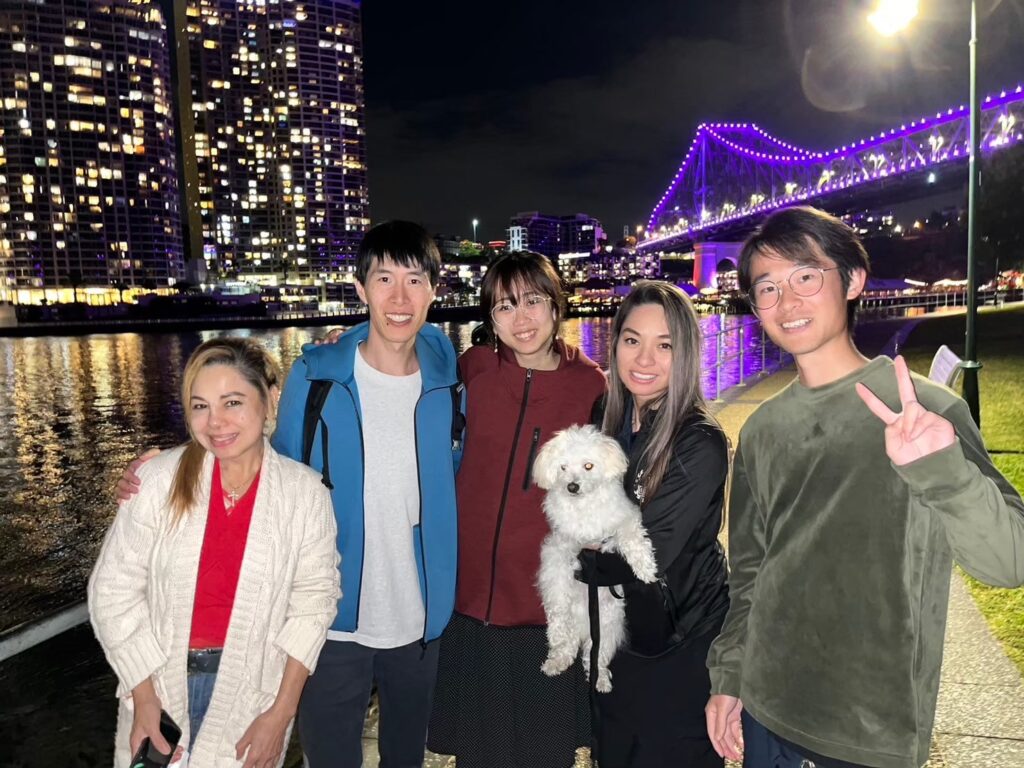
I will share more about the memorable experiences I had in this house in the later section.
Getting around without a car
Public transport
A big reason why we settled down in Brisbane was the presence of public transport. Despite that, many locals would rather drive around their cars. There are so many cars in the city that parking in the CBD is notoriously difficult and expensive.
We bought the local transport card called a Gocard for AUD10 (AUD5 for the card itself). It was possible to get around mainly by bus. The trains are just as nice too. Our nearest bus stop was a short walk away opposite our house and there was a direct bus to the CBD which was very convenient.
However, the bus fares were quite expensive compared to Singapore. It was about $3.60 per bus trip. I remember I had to top up my card so often. We tried to save money by walking from our house to the nearest supermarket which took 20 minutes.
A lucky thing that we did not expect: From August onwards, the Queensland government implemented a trial of 50-cents bus and train fares. Just 50-cents! It helped us tremendously in saving money. We made good use of the opportunity to explore Brisbane and the surrounding areas.

Taxi
If there is a place where you cannot easily access by public transport, you can take a taxi. There are many people who work as private hire drivers. Uber and Didi were my go-to apps. Remember to ask for referral codes from your friends before downloading the app to enjoy promotional discounts!
Finding a job
Once we found a place to rent, our priority was to find a job so that we could continue staying in the city. After preparing our resumes according to the recommended local format, we started focusing on finding a job.
Contrary to our expectations, finding a job turned out to be a difficult process that took us between 1 to 2 months. This is despite having plenty of relevant experiences from our prior working holiday experience in New Zealand. e.g. housekeeping, landscaping, agriculture. I suspect that this is due to a few reasons.
Firstly, it is much more competitive. In December 2024, Australia hit its record number of working holiday visa holders at 206,187, a rise of 40,000 from the past year.
Secondly, it is disadvantageous to be working holiday visa holder in a city. While there might be more job opportunities there, there is greater competition too. Australia attracts a huge number of migrant workers and international students (with limited working rights) who are concentrated in the cities. Employers prefer hiring them over working holiday-ers as they are able to commit longer term.
What we tried
Applying online
During my New Zealand working holiday, I was able to find jobs easily through Backpacker Job Board, an online job portal for working holiday-ers. However, this was not the case on the Australia Backpacker Job Board.
We turned to popular job sites that locals use like Seek, Indeed and Jora. I applied to over 30 jobs ranging from housekeeping, cleaning, f&b to factory work. Each time we had to draft a cover letter tailored to that job. The number of applications that they receive on a single job post must have been too many that they would not give a rejection reply. While we were still hopeful at first, we later figured that it was a waste of time.
I tried joining Facebook job groups for those in the local community or working holiday-ers in Brisbane. It is also very competitive with lots of people interested. Besides, it is quite risky with the numerous fake job posts that are posted by bot accounts.
Handing out resumes in person
Another thing we tried was going around the neighbourhood and looking out for shops that were hiring. As we were in a predominantly Asian suburb, the shops we found were mostly Asian-owned. Some shops displayed hiring posters. (I have since developed a habit of looking out for these posters even when I am in Singapore, haha)
If they have contact details on it, we would text, email or call them. If not, we would hand our resumes to them. But being the introverts that we are, it was no easy feat! We had to muster up much courage to do that. It was a good opportunity for growth as we had to push ourselves out of our comfort zone.
I still remember the time when our landlord brought us to the neighbourhood shops and just walked in to ask straight away if they were hiring. Meanwhile, we followed behind her like scared ducklings!
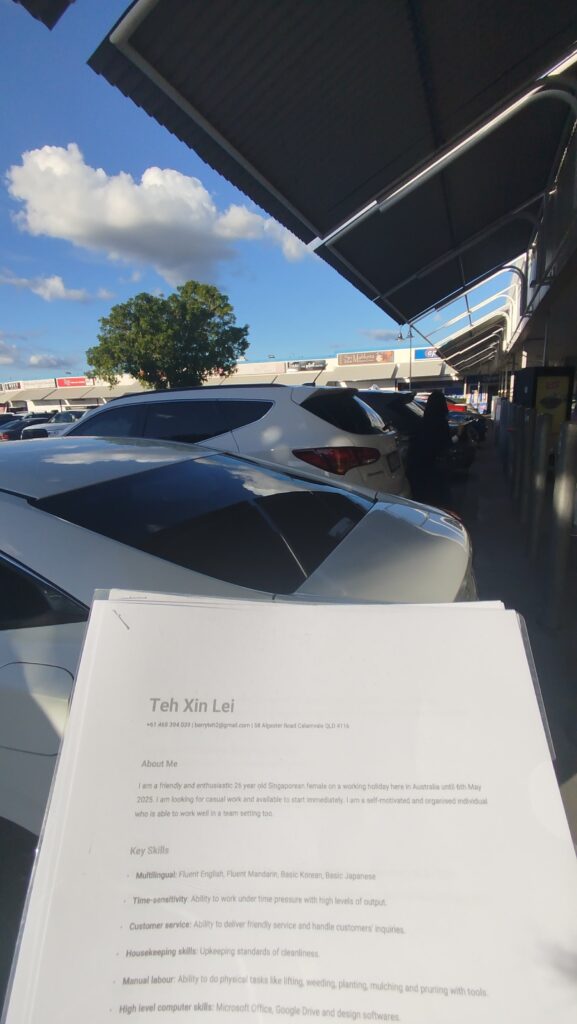
At one point, we considered alternative plans like buying a car or moving away from the city if there were still no leads after 2 months. We began to feel demoralised with the job search when a few things did not work out.
For instance, we did not hear back from the sushi shop that was only a minute walk away from our house even though they were looking for junior staff. We supposed they did not prefer working holiday-ers. We also did not hear back from the strawberry farm that was looking for 200 workers even though we stated our experiences with farmwork.
What worked
Initial signs of success
Our hopes were raised when we found initial signs of success.
We learned about a Korean job portal in Brisbane called SunBrisbane, which we used with some success. I managed to get an interview at a Baskin Robbins outlet but did not get an offer in the end due to my visa limitations. Chiharu got a phone interview from a sushi shop and went for a trial. The owner was happy to offer him the role but he declined it after he found another job because he did not like f&b work.
Later on, I managed to get a waitress job at a hot pot restaurant after contacting the owner via Wechat, a popular Chinese messaging app. I went through an interview which raised a few red flags but I continued with the paid trial nonetheless. In the end, I was given very few hours but I heard from others that it is common in f&b. I only worked a few days before he stopped giving me any work so I suspect that I was used to fill in a gap. I earned just AUD200+.
The other job that Chiharu found was at a Chinese foot massage shop. One thing that we noticed was the unusually high number of massage shops in Australia. As many people are involved in physically-intensive jobs like construction, there is a high demand for massage services. With his experience in massage and a passion for it, he decided to try it. Eventually, he left the job when he realised that he was being exploited.
I will share more about the red flags to take note of in your job search in the tips section.
Leveraging on connections
Ultimately, we managed to find our first reliable job by leveraging on connections. Our housemate, Taiki, suggested that we apply to his company where he was working at. He got the job through direct referral from a friend he met at a hostel who used to work there.
I emailed that company to express my interest and was contacted shortly after to fill in a candidate form. I really was not expecting much at that point after all of the disappointments we have been through. To my delight, I got a phone call a few days later to arrange for a trial! That was when things really picked up.
It took a long 3 weeks after the trial before I could start work. During that time I had to go through online training modules on topics like food safety. The first day of work consisted of an induction where a trainer briefed the new employees and settled administrative matters with us.
First work (2nd – 8th month)
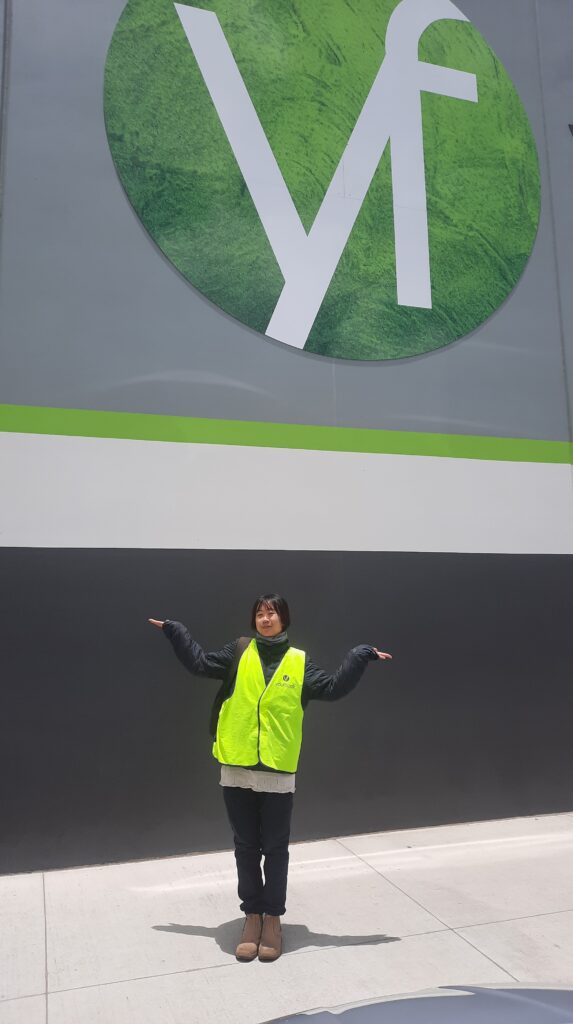
The company is called Youfoodz with the tagline “Healthy eating made easy”. Their only factory in Brisbane makes ready-to-eat meals for nationwide distribution. I worked at the shopping department where I scan orders and pack the required meals into the boxes for shipping to households and wholesalers.
Packer at a ready-to-eat meal production factory
A day in the work
The morning shift starts from 5.30am so I have to wake up at 4+am. (Not a morning person… help) As there is no bus available at that time, I take the taxi which costs AUD16 per trip on average. Thankfully, the factory is located just 10 minutes away by car.
In the premises where I work in, I have to wear PPE (Personal Protection Equipment) in the form of a hi-vest and steel-capped boots. Before work, I put on layers of winter clothing to prepare for entering the freezer environment. (It’s very cold… brrr)
During work, I am stationed somewhere along what resembles an assembly line. As the boxes roll pass, I have to scan the barcode to retrieve information about the orders. The lights on the shelves in front will light up to show the meals that I have to take and in what quantity.
This work is repetitive and physically-intensive (not from the effort but repetitive stress). I have to be fast while maintaining accuracy. After the first few days, my middle finger got very swollen. I chipped a lot of my nails after doing hundreds of thousands of orders.
My work hours depend on the amount of orders in a day. If is a low volume, I can end as early as 10+am. If it is a high volume (>7k), I can end as late as 4+pm. We have a half an hour break at about 9.30am. On average, I end at 1pm. That gives me the rest of the day to chill and do what I want!
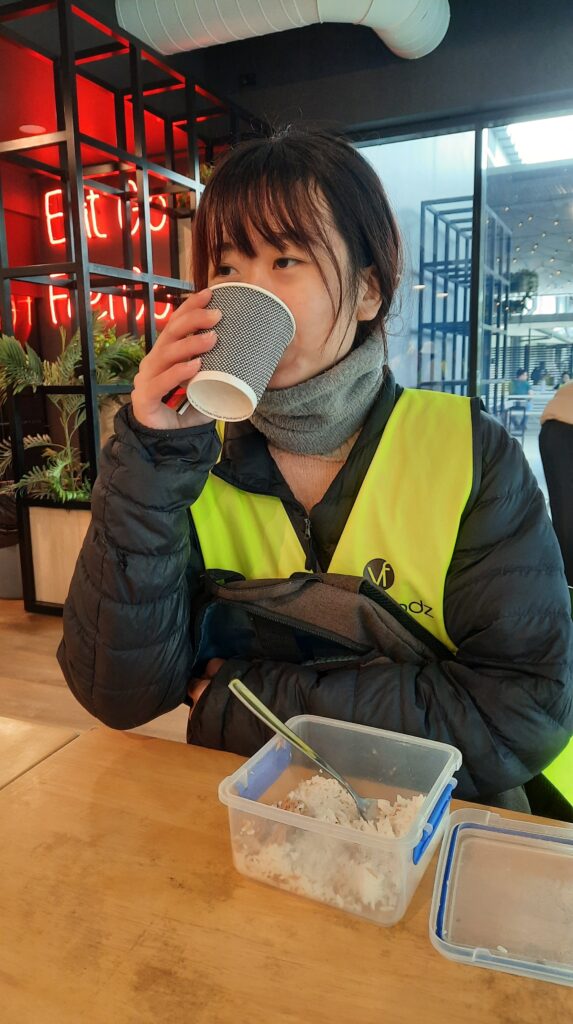
Earnings
Australia has a minimum wage of AUD24.10/hour. I could earn AUD25/hour. The hourly wage is 1.5 times on weekends and 2.5 times on public holidays. Imagine earning AUD60/hour!
I was usually scheduled for 4 shifts per week, totalling to 30+ hours. Sometimes the supervisor would ask me if I wanted to work on an additional weekday or Saturday, which agreed to if I had the capacity to. I did not request for more shifts like some of my colleagues did as I preferred to keep my work-life balance.
Our salary was given out weekly. I could earn about AUD800 each week. If I pushed myself to work more, I could earn up to AUD1000 which is quite crazy. There and then I understood why so many people wanted to work in Australia for the “big money”. Honestly, it can become addicting to see the numbers in your bank account increase so much every week.
Perks
One of the perks of working at Youfoodz was the free meal that I could get per shift worked. There was a vending machine near the kitchen that would be stocked up with free meals. I often took the meal home for lunch. Sometimes there would be free snacks at the pantry too. Free food is the best~
Sometimes, the company would hold special events like a food truck or barbeque. It was the best reward after a hard day at work!
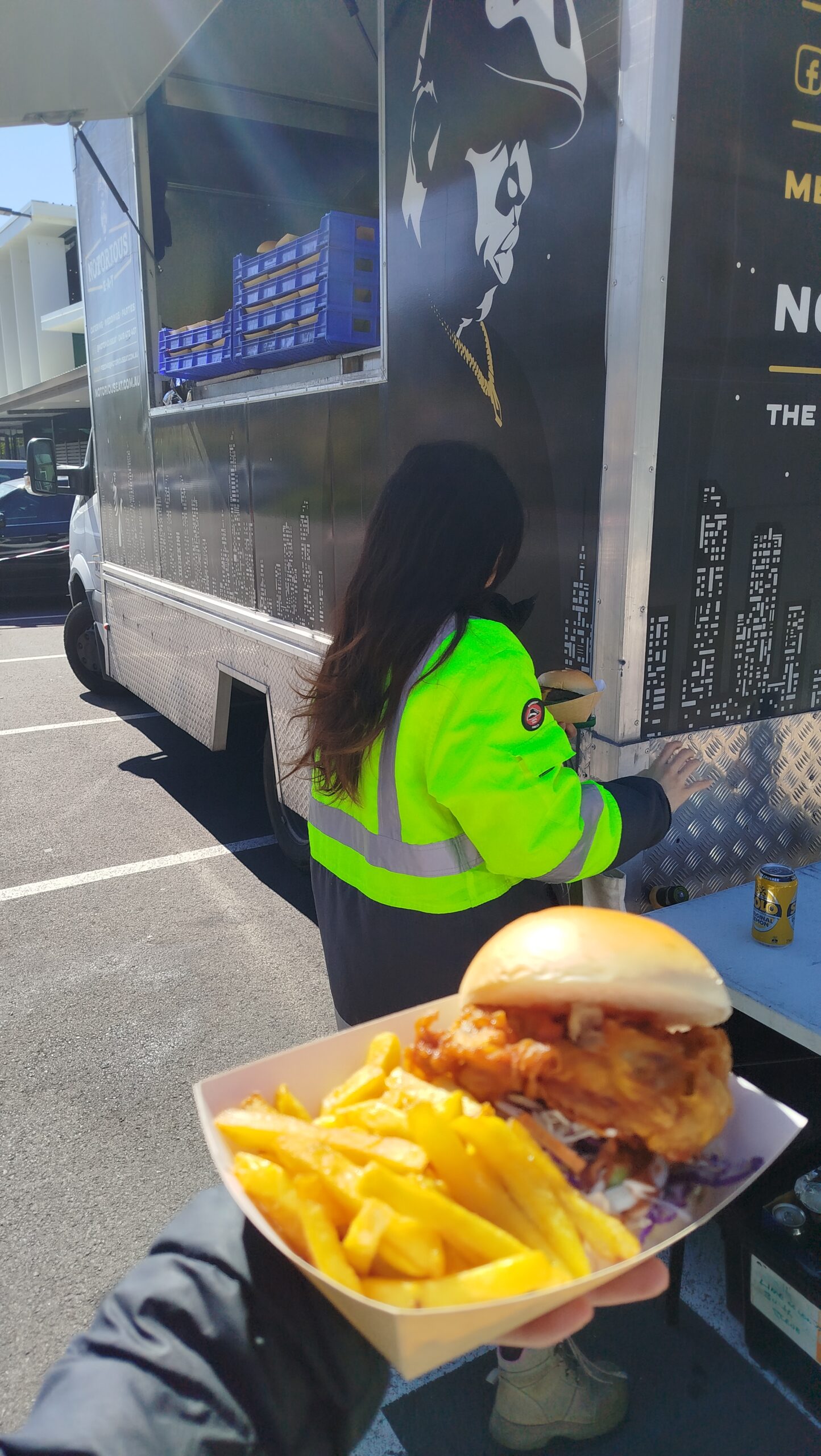
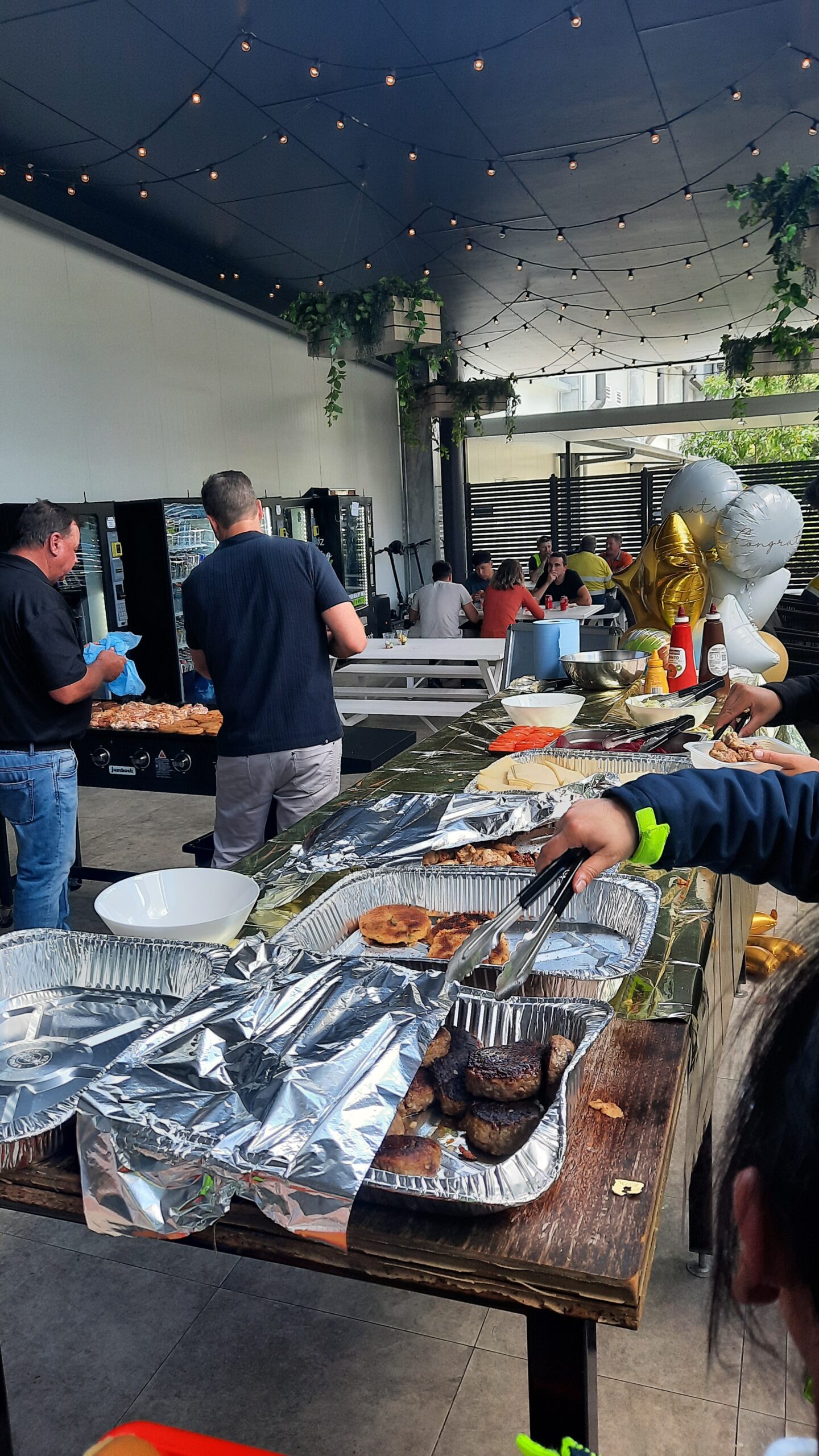

The most memorable event was the end-of-year party. I was really glad I signed up for it (Saying this as someone who identifies as an introvert… not a party animal! ) The party was held at a club in Fortitude Valley, an inner suburb known for its nightlife. It was tropical-themed so we were supposed to dress up according to that.
There is something peculiar about seeing your colleagues who are usually in their PPE dolled up for the first time. (I couldn’t recognise some of them lol) The party gave me a glimpse of club culture in Australia. There was a bar with drinks and waiters going around with platters of finger food. And then it was time to get down on the dance floor! Chiharu and I kept dancing until we were too tired.
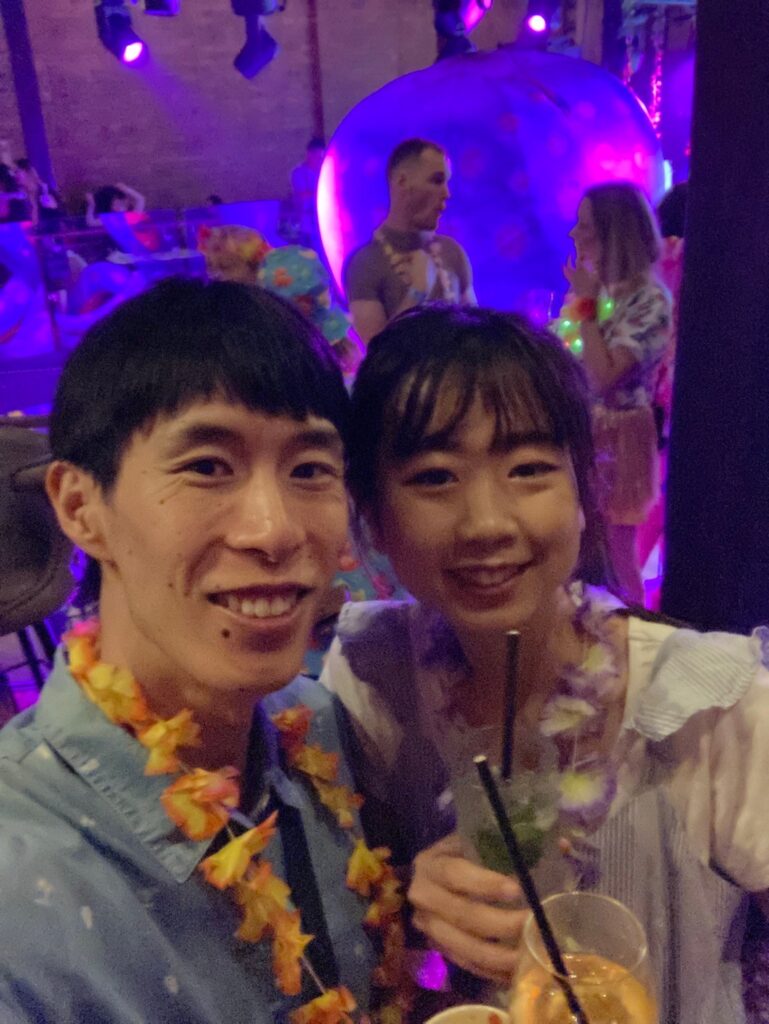

Experiences in the city
House parties
I could see that community is a big part of Filipino culture. Our landlord Emma often hosted gatherings and parties at her house. It was an eye opener for Chiharu and I who have not been exposed to such a culture at home. In July and August alone, we had 4 birthday parties! (Including mine and Chiharu’s) We really enjoyed the food and atmosphere.
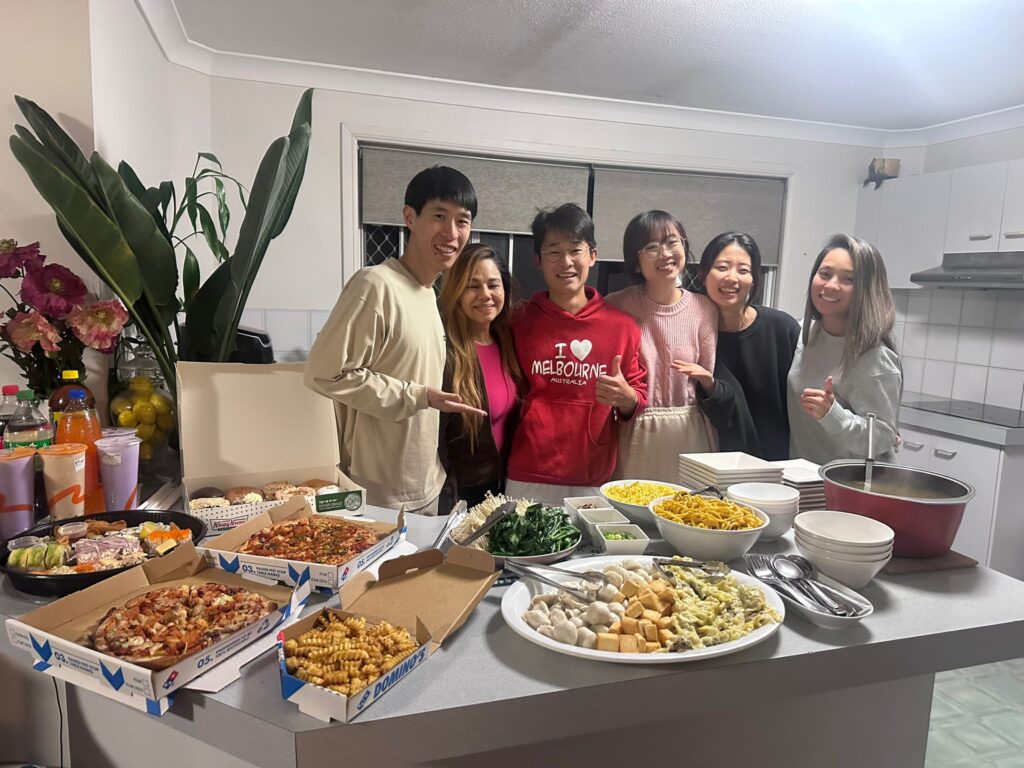
A highlight was the Christmas Eve party. Emma set up lots of decorations in the house (which I helped out with abit) 1-2 months before Christmas. It was a cool experience because my family in Singapore does not celebrate Christmas. It gave us a glimpse into the Filipino and Australian way of celebrating Christmas. We ate lots of food, played games and even got presents from Emma.
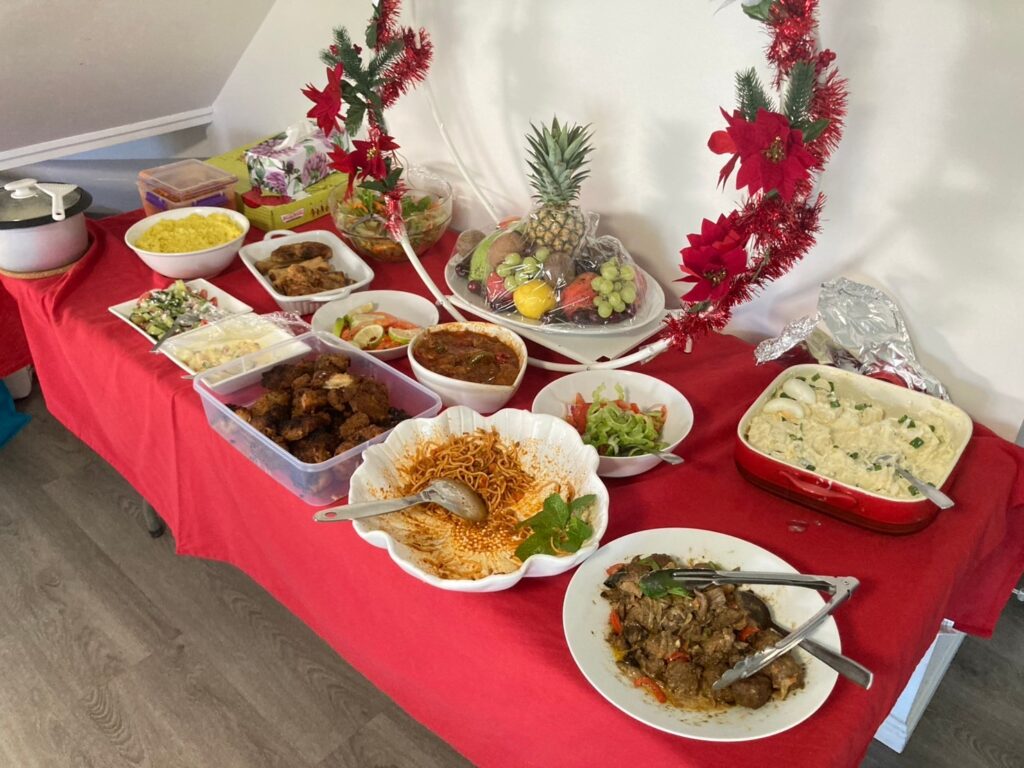
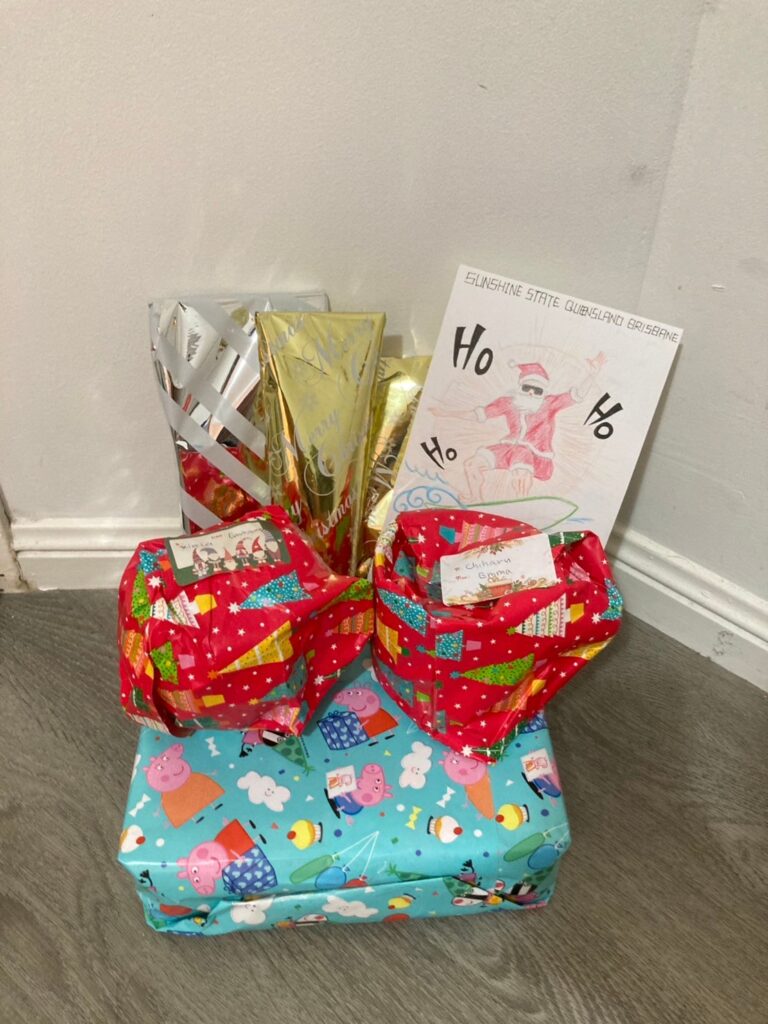
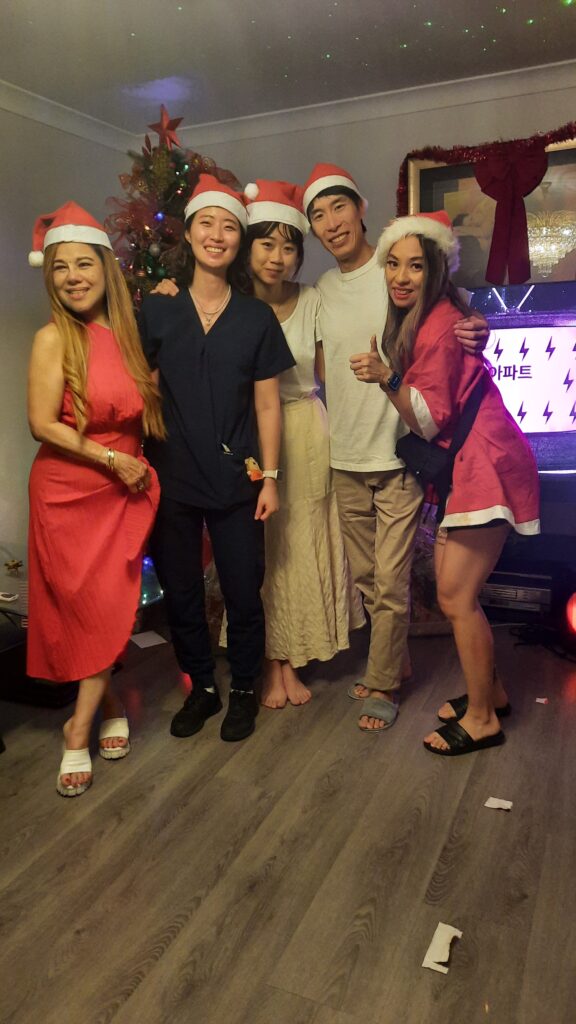
Enjoying the CBD

The Central Business District was one of our favourite places to go to. As much as I say that the city is not for me, I must acknowledge that the CBD in Brisbane is beautiful. It gives off a modern and dynamic vibe.
There are several places of interest in the CBD such as the Queensland museum, Kangaroo point and City Botanic Gardens. One of the activities we enjoyed was taking a free cruise along the Brisbane river on the CityCat, where we could see the Story bridge that lights up colourfully at night. On our days off, we liked to go chill at the South Bank where there are eateries, green spaces and a man-made beach.

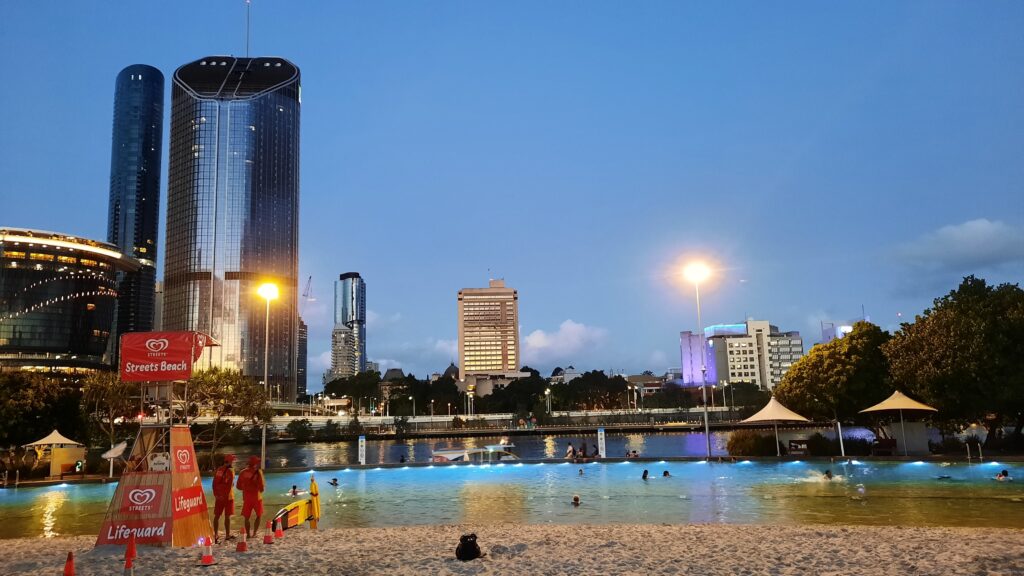
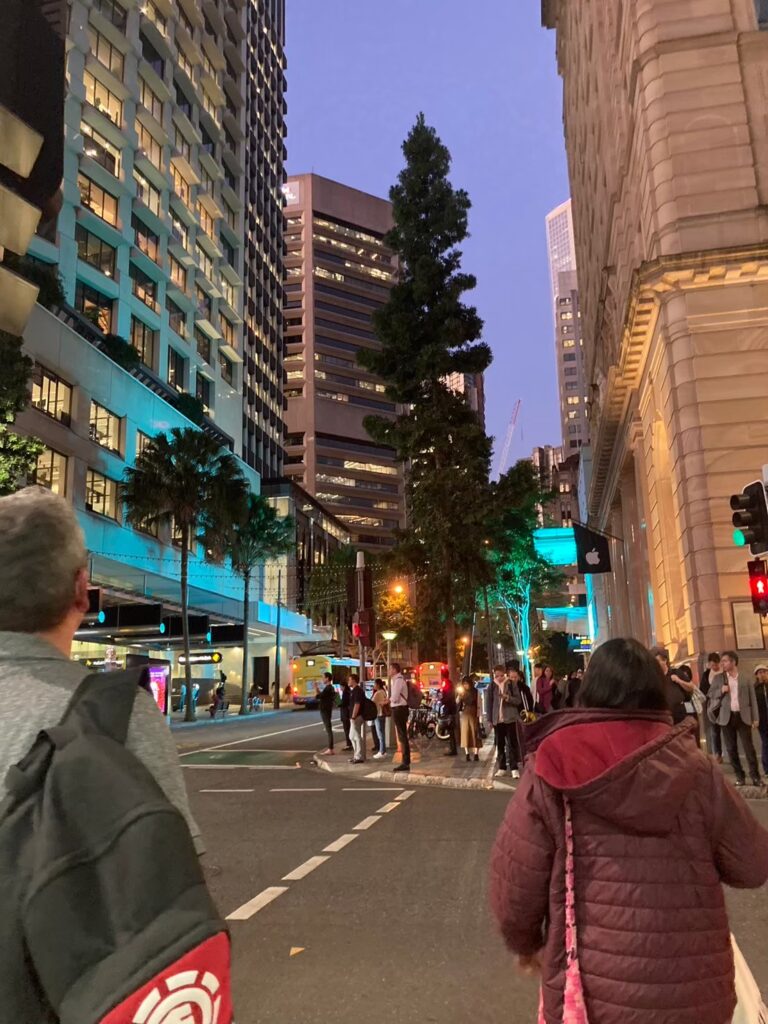
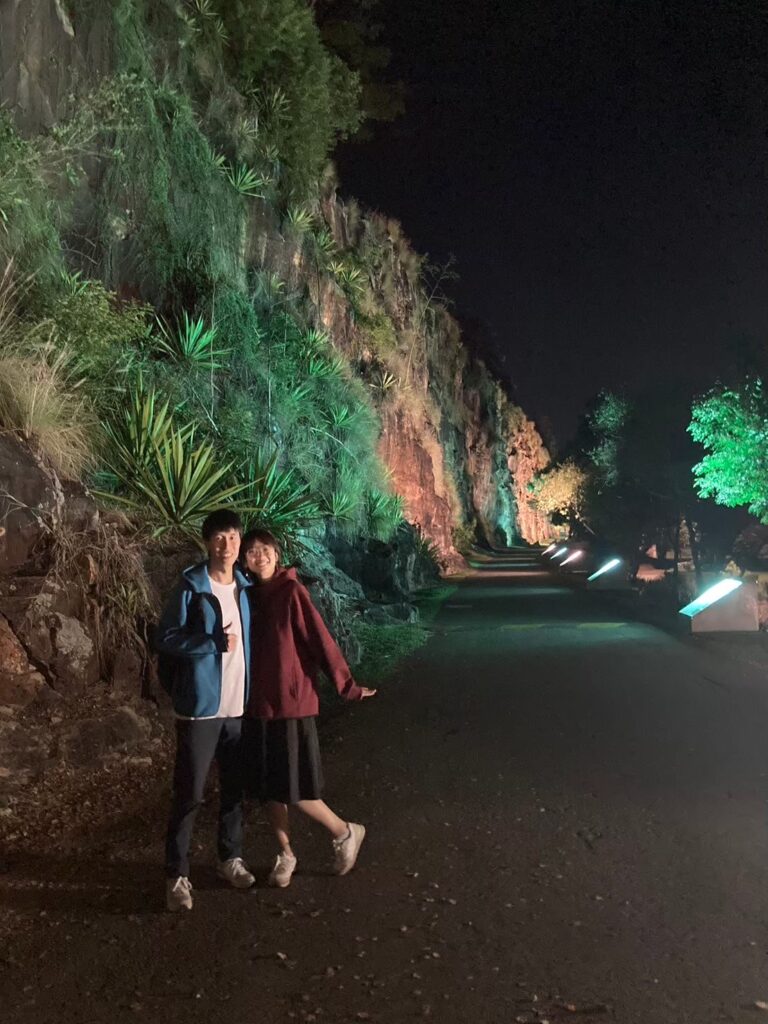
August saw the opening of the The Star Brisbane, a luxury hotel and casino. It reminded me of Marina Bay Sands in Singapore. We went up the Skydeck where there is a glass floor. (Chiharu was scared to stand on it haha) The view of the cityscape from there was simply spectacular!
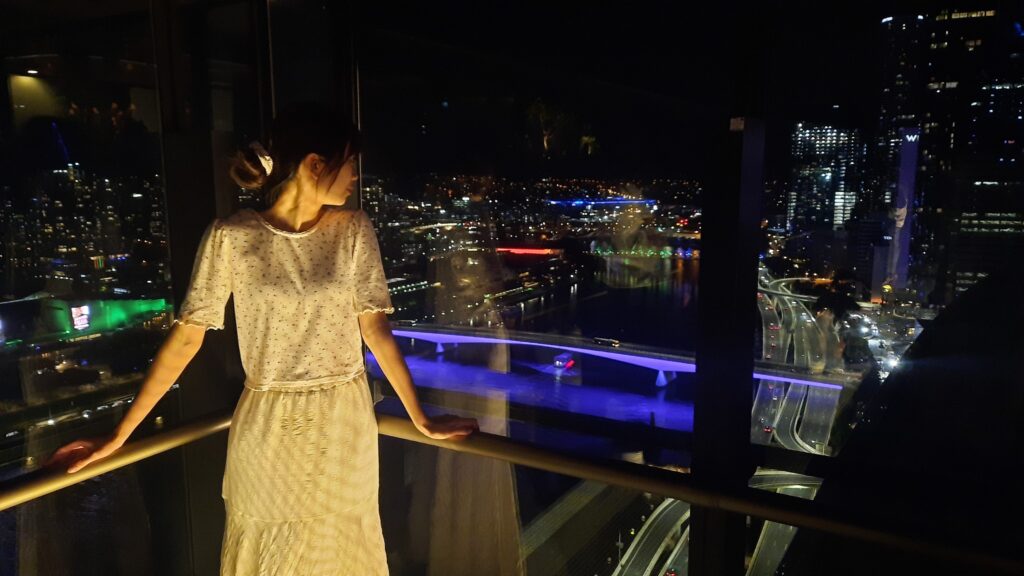
One of the pros of living in the city was access to large scale events. For example, we could catch massive fireworks displays during Riverfire, held as part of the Brisbane Festival (annual arts festival in September), and the New Year Eve countdown. We also caught the festive vibes in the CBD for Christmas as well. There was a cool projection mapping show at the City Hall that featured a local theme of Christmas. Picture Santa in the tropical heat and wallabies on a sleigh!
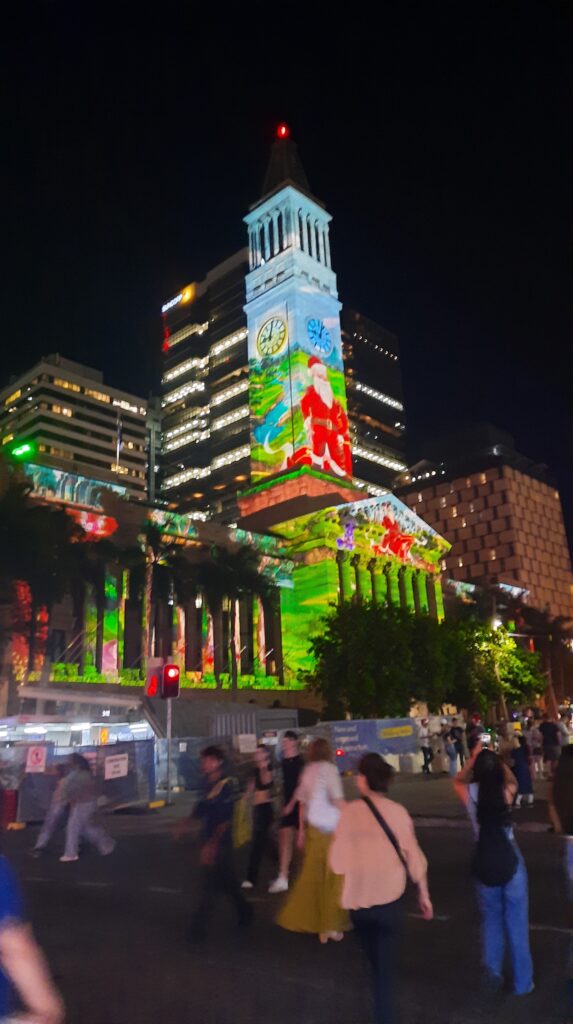
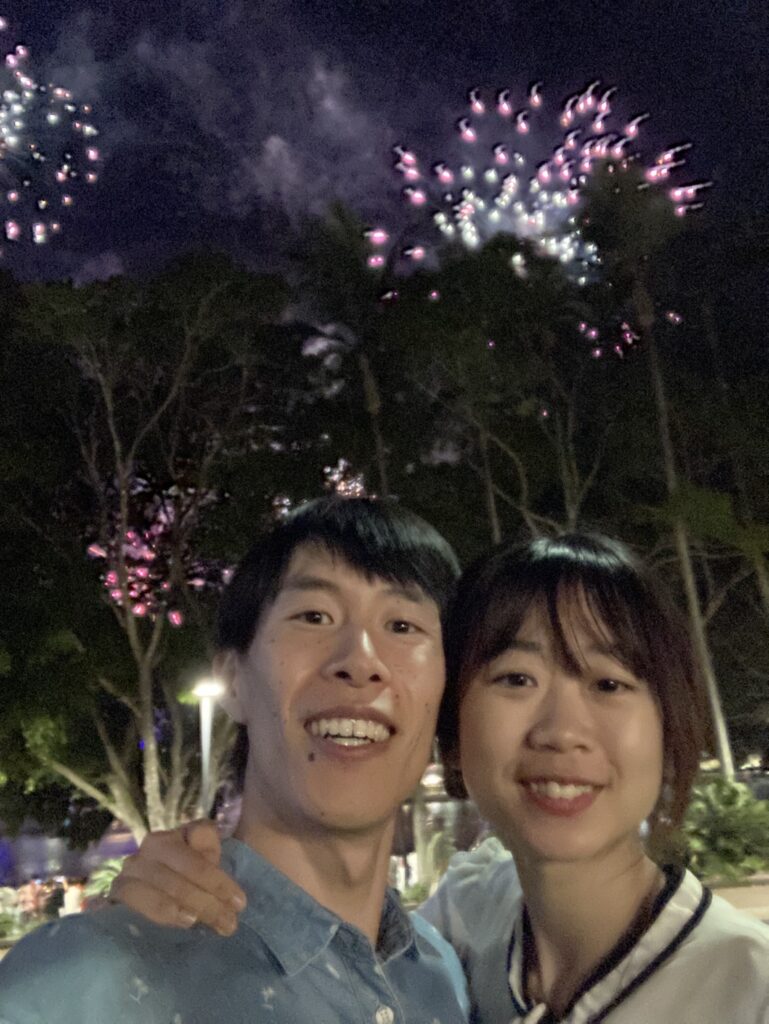
Volunteering as an English tutor
The nice thing about settling down long term (3 months or more) in a city is the ability to commit to new and exciting projects.
The idea of volunteering came up for me when I was thinking how I could expand my local community. I found an opportunity to be a volunteer tutor for the Adult Migrant English Program at TAFE Queensland, a large government-funded vocational school. As I have been interested in language teaching, it felt like the perfect opportunity to gain useful experiences while meeting new people.
I chose to volunteer as a classroom assistant once a week on my day off. I was lucky to work alongside a teacher who has 30+ years of experiences teaching English as a second language. Through her classes, I was able to observe her professional methods of teaching. The class consisted of elders from China whose children have immigrated to Australia. They were a lively and humorous group who liked to joke around with the teacher. An interesting fact is that Chinese Australians make up the largest group of Asian Australians and one of the largest groups within the Chinese diaspora in the world.
A memorable activity was bringing the students on a field trip to the neighbourhood to practice English in real-life settings. It was encouraging to see the students try their best. We went to the restaurant and one student treated the teacher and me to lunch. He said it is a Confucian value to respect teachers and take care of the young. I never forget that!
This volunteering experience showed me the reality of immigration from the migrants’ perspective. I have great respect for the students because it must not be easy to settle down in a foreign country where they have to learn a new language and set of customs.
Studying Japanese
Another project of mine was studying for the Japanese Language Proficiency Test (JLPT) N4 level. While I had been wanting to take the test since my university days when I started learning Japanese, I never got down to it. But I told myself, “No more excuses!”.
Taking action to commit to something is very powerful. I applied for the December test at the Gold Coast campus of Griffith University and paid over AUD90 for the test fees, essentially forcing myself to commit.
Studying while working is no easy feat but I managed it with consistent effort over 3 months. On the test day, my best supporter Chiharu accompanied me to the test venue and waited for me. I felt a great sense of accomplishment after that even though I was only going to know my results 2 months later. The point is not the results, but taking a step to overcome the first barrier to whatever you have been wanting to do.
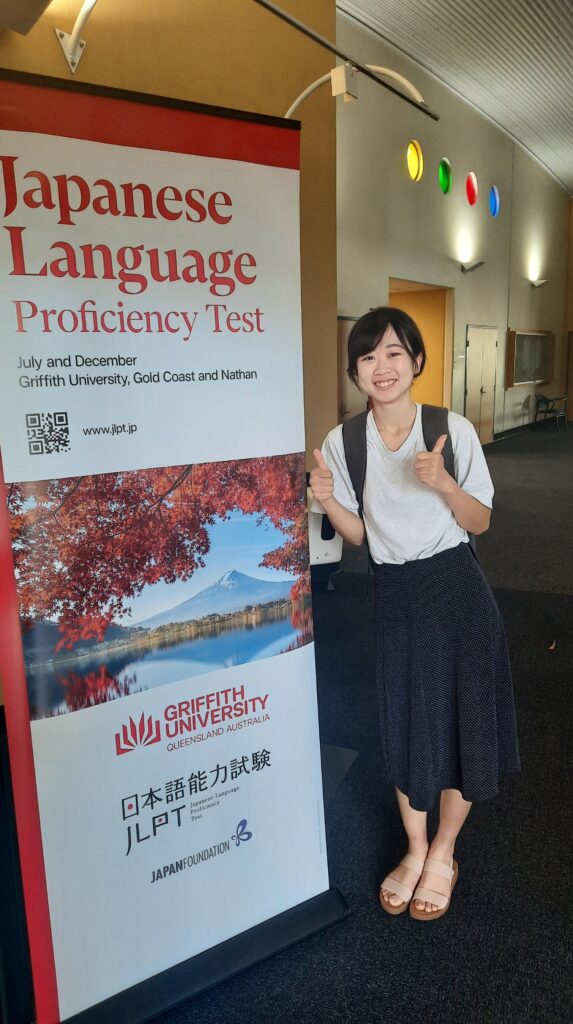
Learning self-defence
Sometimes unexpected things can happen when you open up to strangers. An instance of that was when I befriended a local, Mark, who was my Uber taxi driver. During our conversation in that short trip, he told me that he travelled Asia in his younger days and trained in martial arts. When he mentioned that he teaches self-defence to travellers, I was immediately interested. Chiharu and I decided to give it a try with Mark’s lessons as we had safety concerns about our future travels.
Until the point we left Brisbane, we attended his weekly lessons. He teaches a group of students at a local community school. He taught us a variety of techniques such as how to deal with a knife attacker. Besides physical techniques, he also taught us about psychological techniques such as how to maintain awareness of our surroundings. As a result of his teachings, we gained more confidence (especially Chiharu who said he wanted to protect me haha)
What is amazing about Mark is his passion for what he does and his kindness. He offered free lessons to a child in the community who was bullied at school. He shed some light about how it was like in the past in Australia where there was stronger racism (He is half-Chinese). I definitely learned a lot from his story.
Check out what he offers here.

Setting up a small business (weekend market)
Since my days in New Zealand where I was exposed to weekend markets, I started thinking about setting up a craft shop. My working holiday in Australia seemed like the perfect time to fulfill this dream with the presence of a strong crafts culture.
For a few months, I made crafting my passion project outside of work. I decided to work on shrink plastic earrings. I ordered all the materials I needed online and conceptualised a series of designs. It had always been my dream to create a handmade brand that reflects my style. Behold, Sunny buds was born! It is inspired by nature and agriculture, consisting of fun and colourful designs.
There are some actions that you need to take to set up a weekend market stall. Firstly, you need to apply for an ABN (something like the TFN) online. This is necessary for doing any kinds of business in Australia. Secondly, you need to buy product liability insurance. I got mine from AAMI at AUD91 for 3 months. You will be asked for the certificate when filling in the application form for weekend markets. Lastly, you have to prepare the logistics for your stall set-up. The basic items are a gazebo, gazebo weights, a trestle table and a chair. I bought a table at Bunnings and ordered other things like decorations from online.
Finally, I managed to set up my stall at 2 weekend markets during Halloween and Christmas respectively. The first one was at the Riverside Market at City Botanic Gardens and the second one was at the Mount Gravatt Sunday Market. I can never forget the feeling of making my first ever sale. Surprisingly, my designs were really popular with children! (Although they couldn’t buy it I was really happy when they said it is cute)
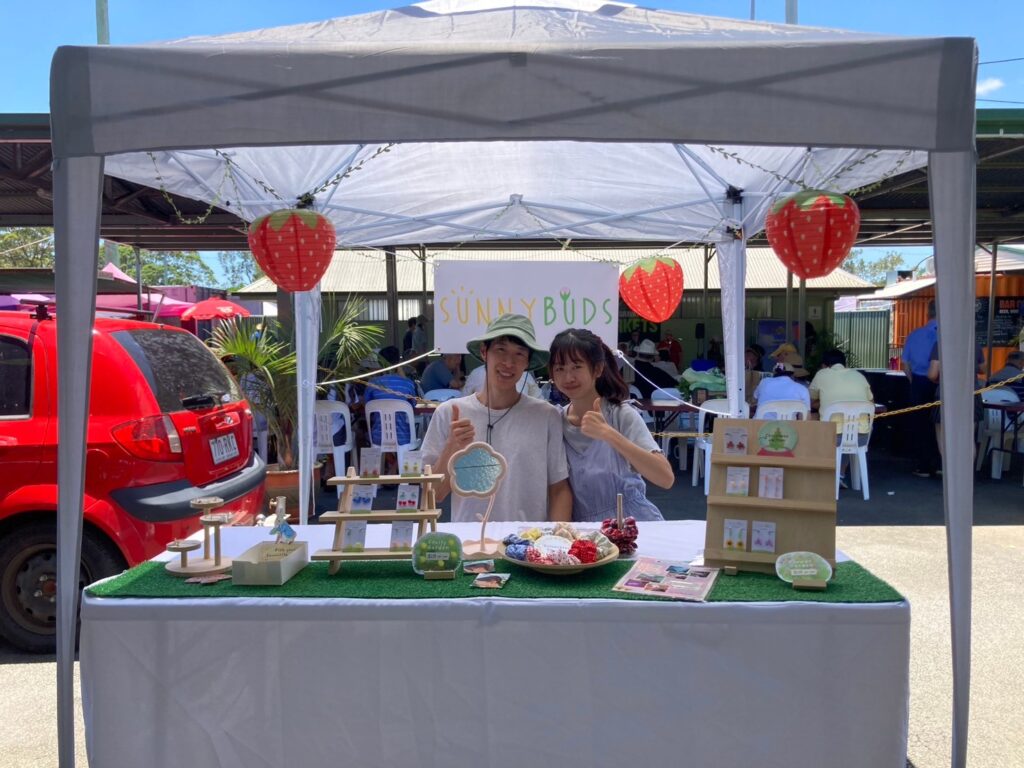
The costs of setting up a stall is not cheap when you consider the rental fee (AUD55 and AUD70 respectively) and taxi fares. Unfortunately, I could not cover those through sales. On hindsight, we might have done better at a craft market instead of a general market where people tend to go for food and produce. A vendor at a market shared with us that it took her time to build up a customer base, something we were not able to do as visitors.
Like I mentioned before though, the point is not the results but the fact that I took up the challenge and created a lasting memory.
Adventures
Day trips
How could we miss the chance to explore the Queensland region while we were in Brisbane? On our days off, we tried to visit some places on the outskirts of Brisbane city. It is possible to take the public train to some of these places and come back within a day. (50 cents fare, why not?) We visited 4 places: Gold Coast, Ipswich, Toowoomba and Australia Zoo.
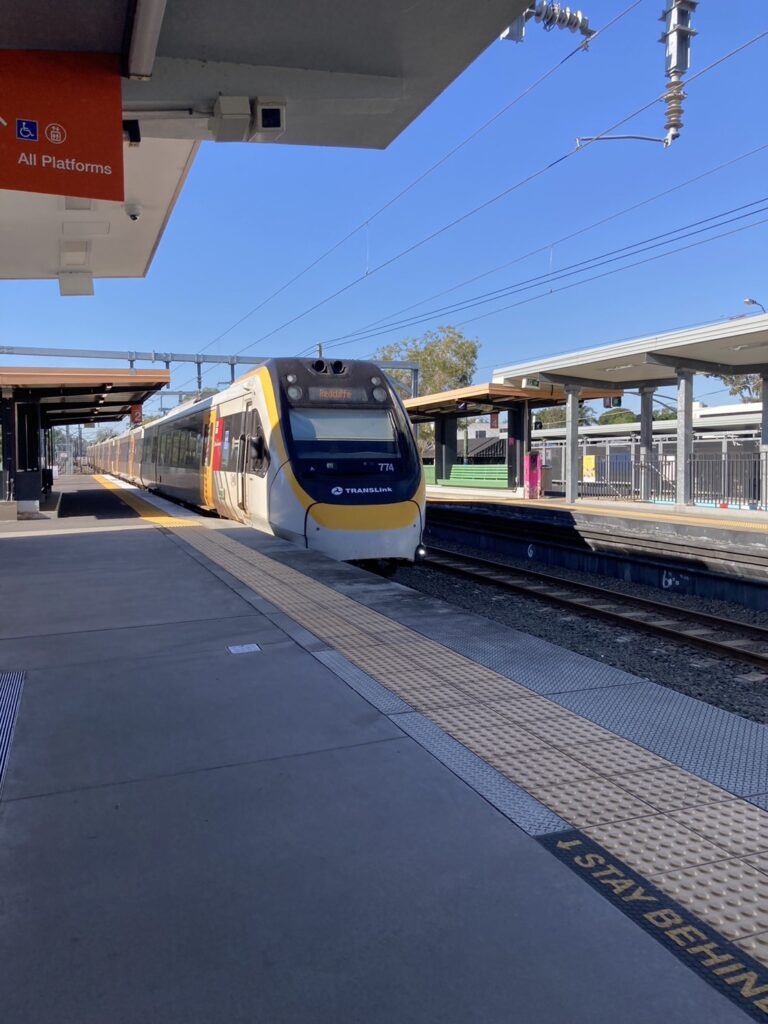
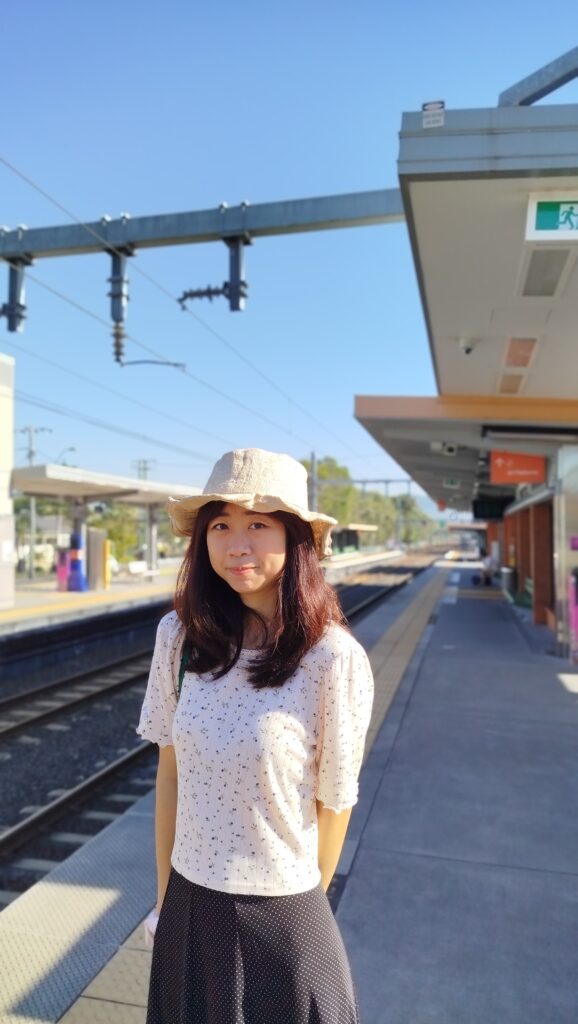
Beach out at Gold Coast
From Brisbane, it takes just over 1 hour 30 minutes by train to get to Gold Coast. This famous coastal city is known for its surfing beaches and theme park attractions. Chiharu and I went there a couple of times to enjoy the beachy vibes. Nightlife is quite vibrant too. I personally feel that Gold Coast is quite touristy though. The theme parks are expensive and the numerous luxury properties there remind me of Sentosa Cove.
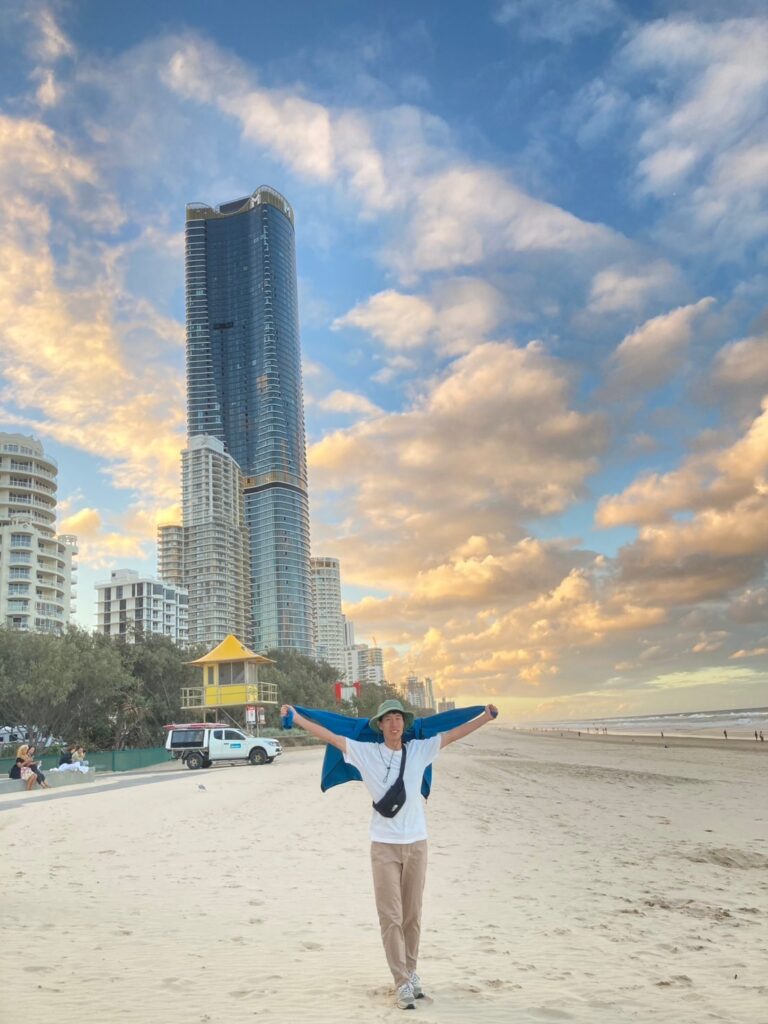

Festive Ipswich and Toowoomba
It is a good idea to discover new places during festivals where there are exciting activities lined up. The first place we visited was Ipswich during their heritage festival called Galvanised. Immediately, we felt very different vibes from Brisbane. It felt more peaceful and people were friendlier too.
We signed up for a heritage bus tour by the Ipswich Historical Society which was really informative and cool. We hopped onto this lovely vintage bus that took us around the neighbourhood. The tour guide explained to us the history of the places we stopped by, informing us about the rich mining history of Ipswich. After that, we got to take a look around the centre which gave us a glimpse of life in the past.
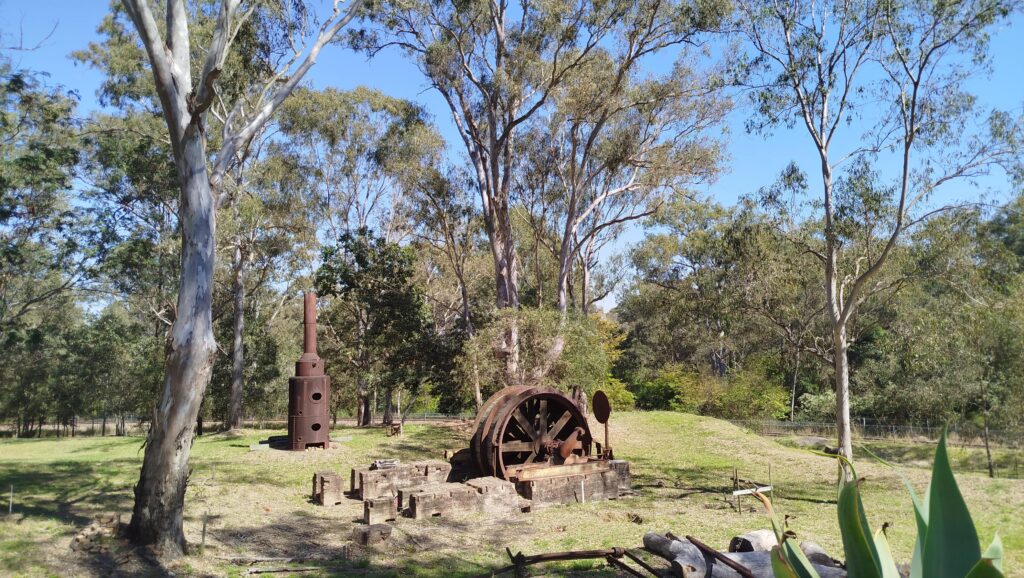
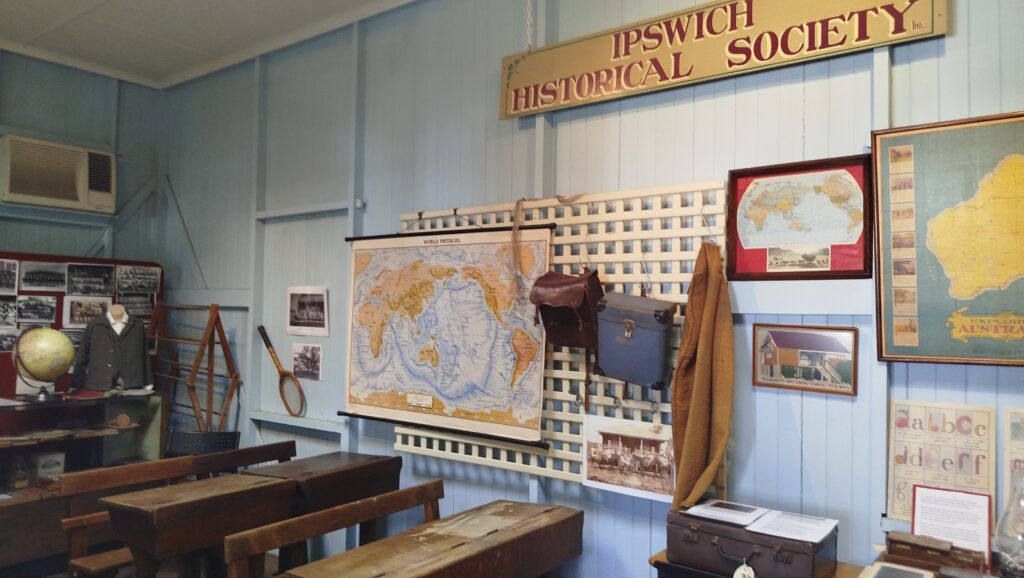
We also took a steam train at the Queensland Museum Rail Workshops. I really liked the interior of the train. It took us around for an hour. Choo choo! We looked around the museum after that and learned about the history of the railway development in Australia.
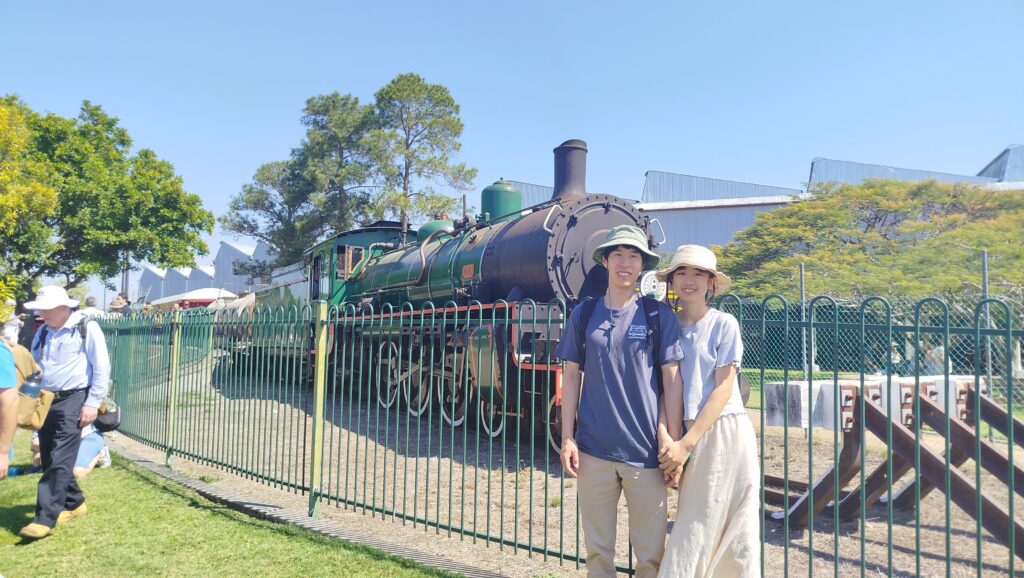
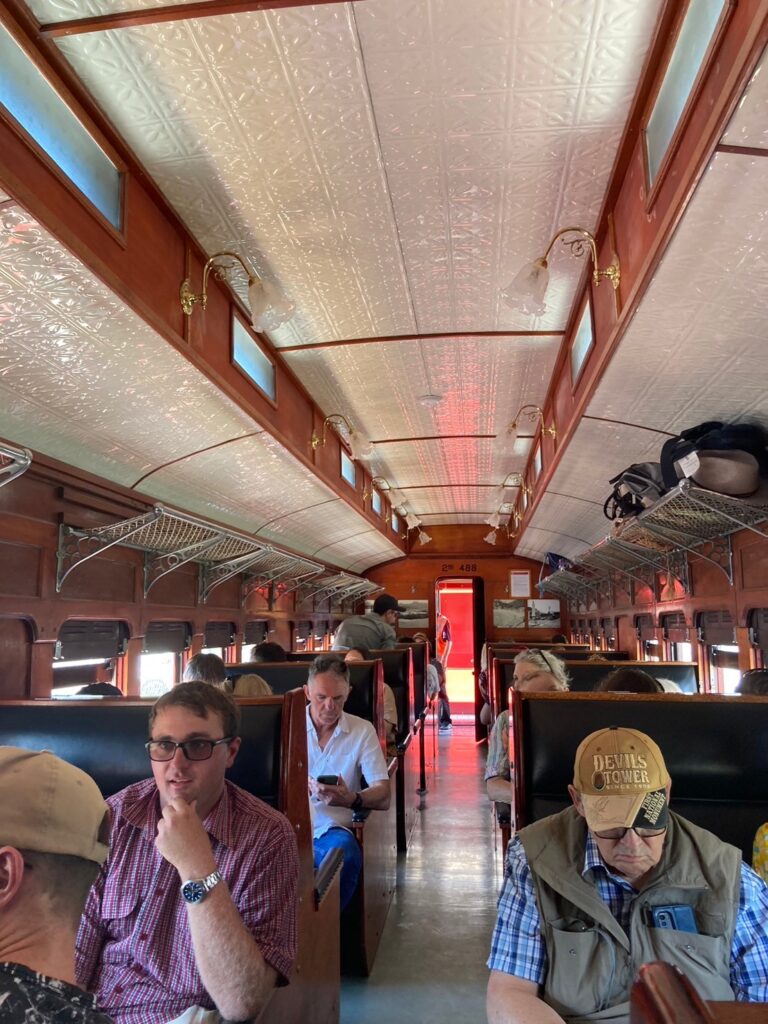
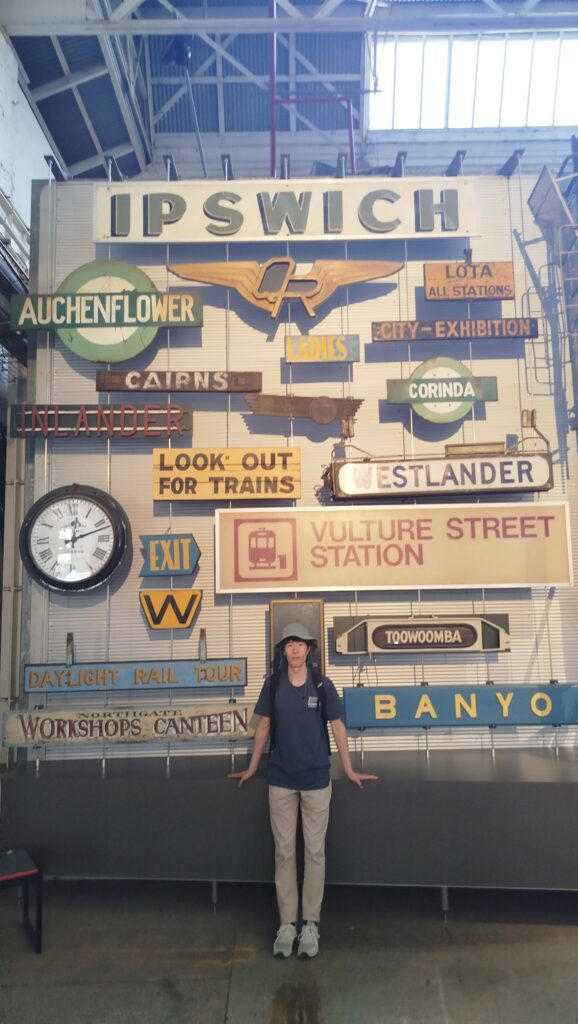
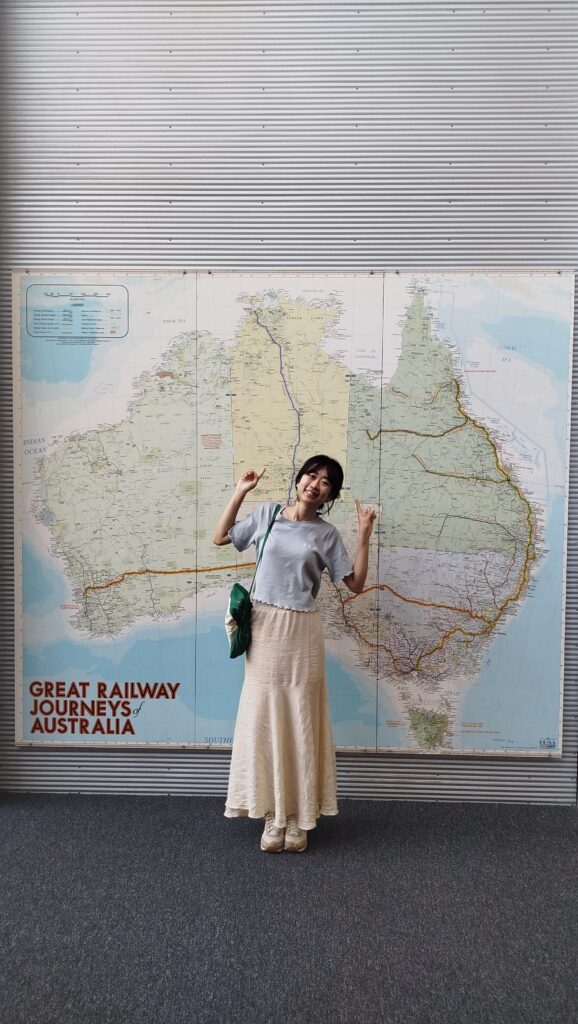
As it came to springtime, we visited Toowoomba for the Toowoomba Carnival of Flowers. The beautiful floral displays attracted a crowd like bees to flowers! We particularly enjoyed the town parade which showcased the creative creations of the local communities. After that, we went to a lookout to view the Table Top mountain, a cute flat-topped mountain.
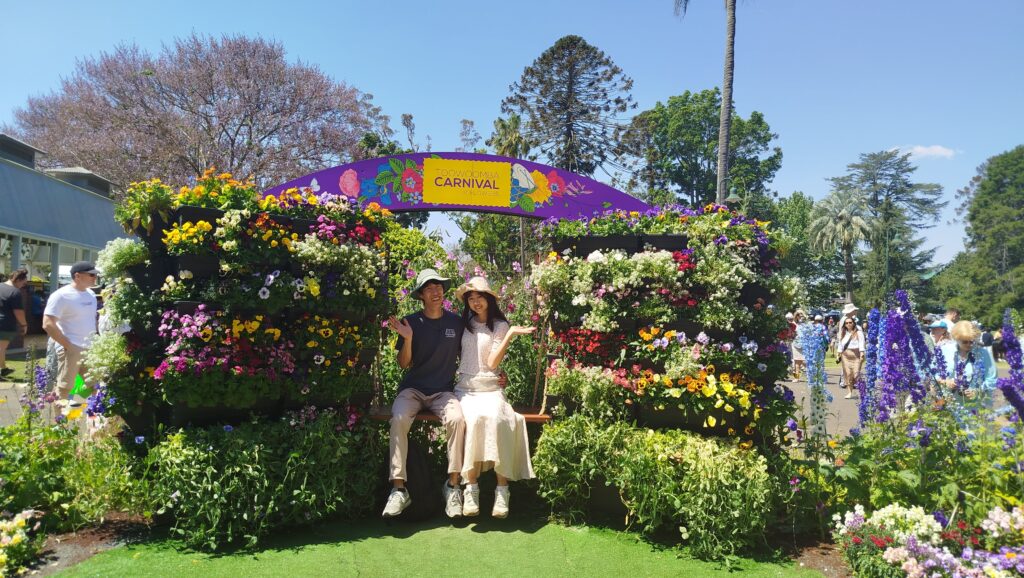

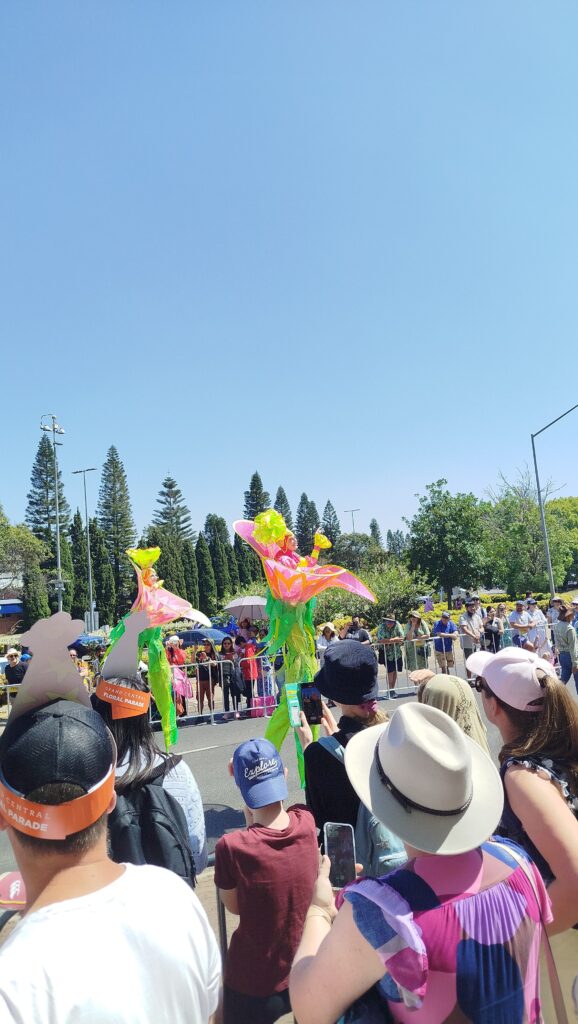
Bucket list #1 – Australia Zoo
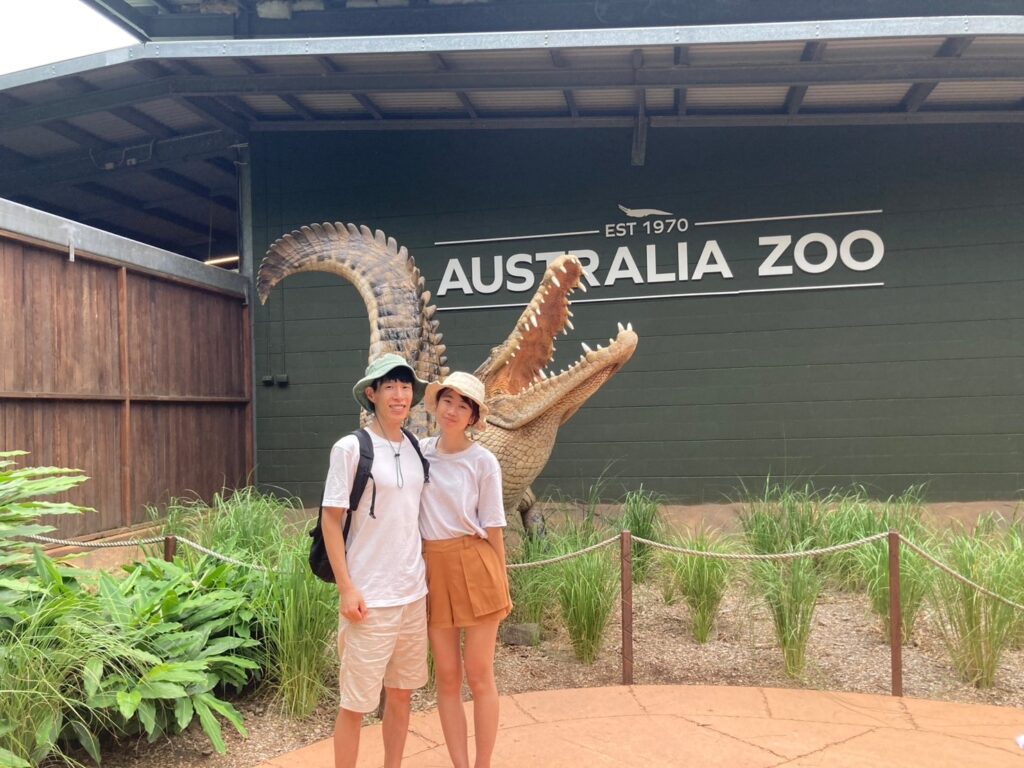
Australia Zoo is a must-visit in Australia if you are nearby in Queensland.
It is a continuing legacy of the late Steve Irwin who was a famous Australian zookeeper, conservationist and TV personality. I knew him since I was a primary school kid and remember being struck by the news of his death doing what he loved. (He was killed by a stingray) The Irwin family which consists of his wife, daughter and her husband, and son still works in the zoo.
We went there early in the morning by train and bus which took us 2 hours 30 minutes from Brisbane city centre. An adult ticket costs AUD71.95. It may not be cheap but I am happy to fund wildlife conservation. At the entrance, we were greeted by a big crocodile statue. Steve Irwin was known as The Crocodile Hunter. If you are into reptiles, you are in for a treat at the Australia Zoo with the numerous crocodile and snake exhibits (including the world’s most poisonous ones!)
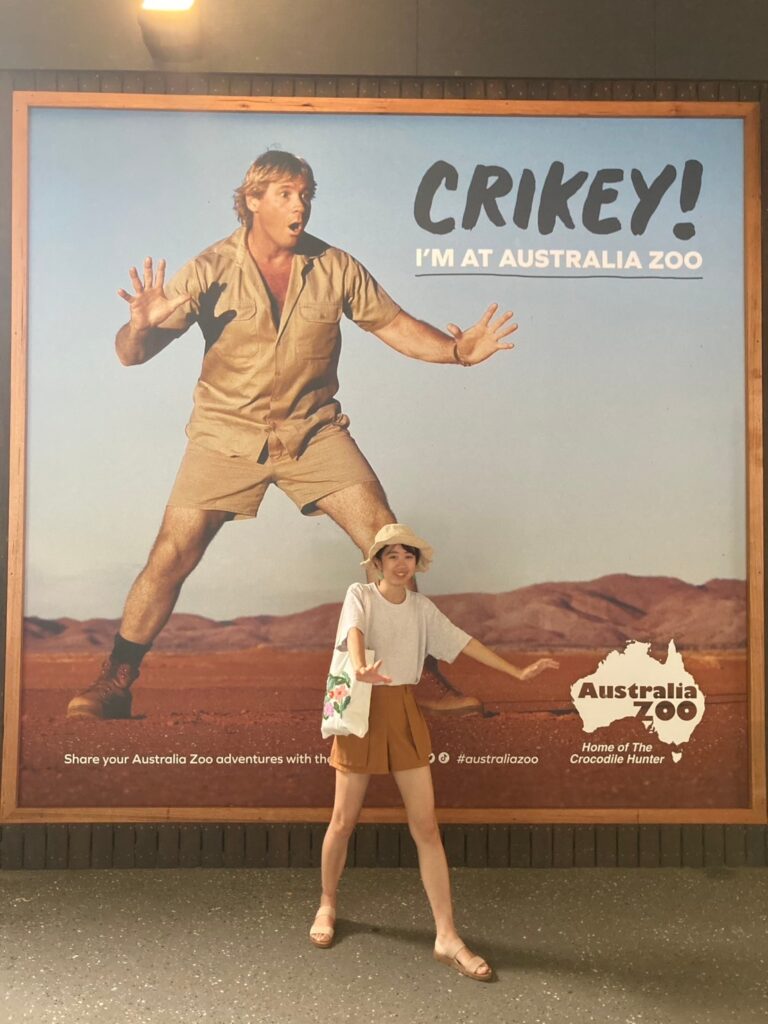
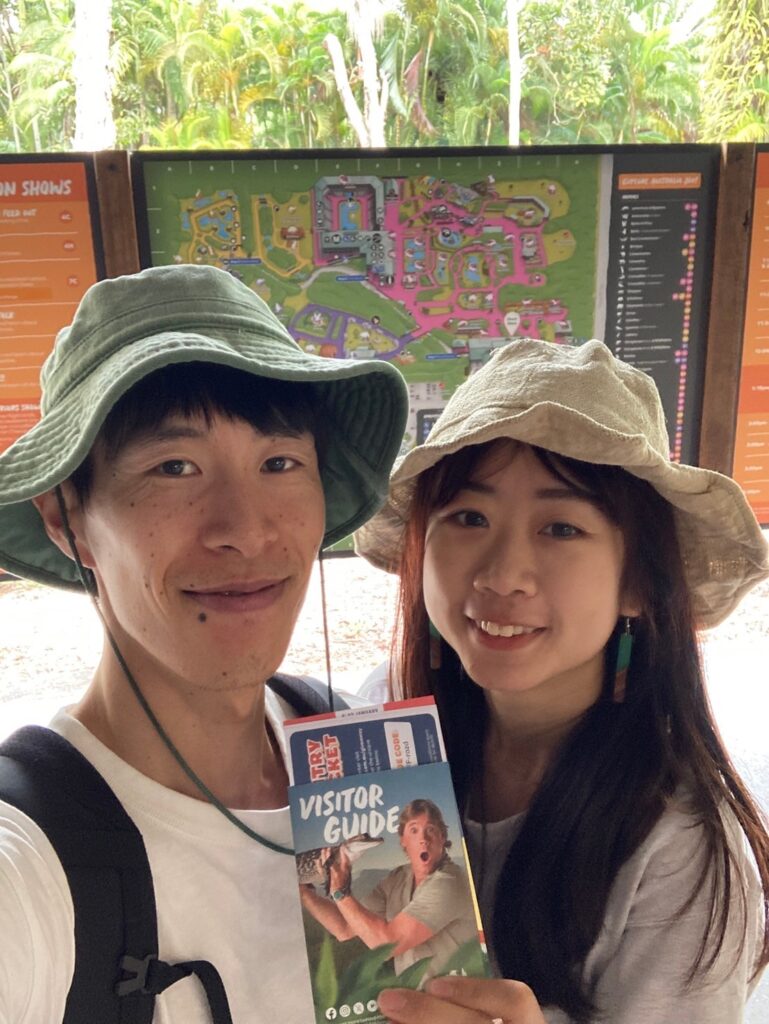
We were excited to explore the zoo. Different parts of the zoo showcased different animals ranging from African to Southeast Asian native animals. Of course, we were the most interested in the Australian native animals. The most popular were the koalas and kangaroos. The kangaroos were housed in an open space where visitors could get up close to them. I was happy to see a wallaby for the first time too. A wallaby is like a tinier version of a kangaroo. A real cutie!


The other Australian native animals that we saw were the echidna, quokka, tasmanian devil, wombat and cassowary (the heaviest local bird). My favourite was the wombat! It moves in a clumsy way. I was lucky because it came up right in front of me and we stared lovingly at each other for a while. I later bought a wombat plush toy at the shop lol.
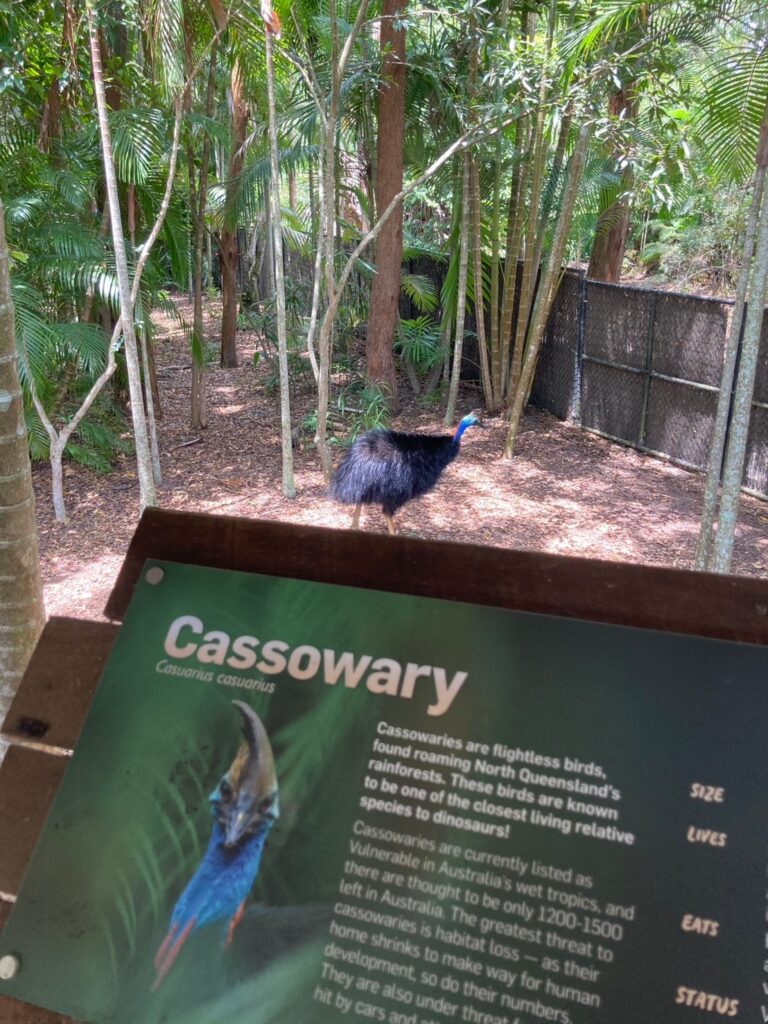


The highlight that all visitors were looking forward to was the Wildlife Warriors show in the afternoon. It was held at the Crocoseum, a grand stadium with a specially-designed swimming pool for crocodiles. The show consisted of a bird performance and crocodile feeding. It felt like meeting celebrities in real life when Bondi and Chandler appeared. Watching the crocodiles come out and go after the meat was a heart pumping experience! At the end of the show, the TV display showed past clips of Steve Irwin doing the exact same things. I left feeling really inspired by his passion.
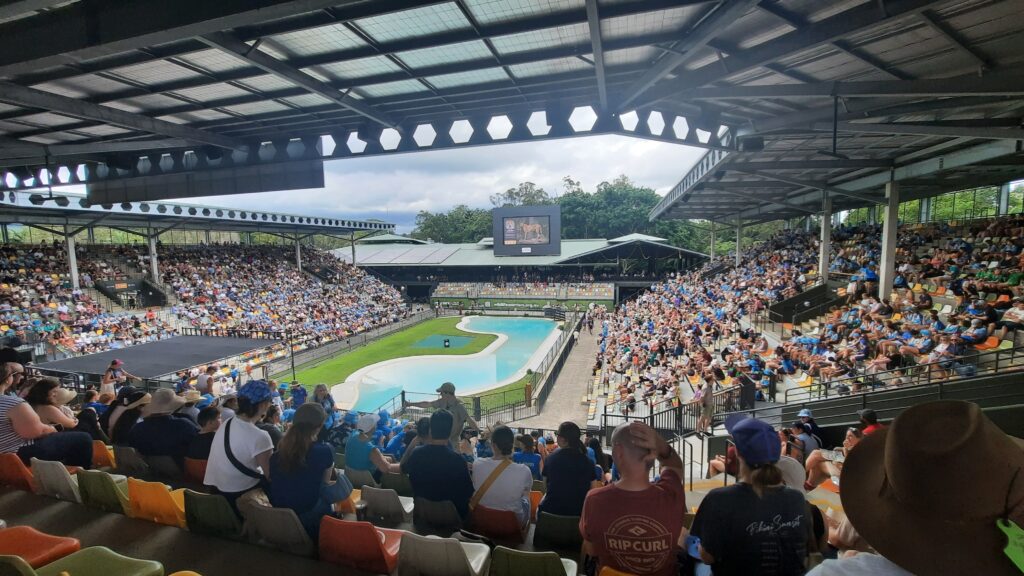
Overall, I would highly recommend a trip to the Australia Zoo. In fact, Chiharu used to have reservations about zoos. He feels uncomfortable seeing animals trapped in enclosures for entertainment. (At least in Japan, zoo conditions are not ideal) Despite that, he was happy with the trip. So it really depends. From what we saw, the animals were well taken care of and there was a heavy emphasis on conservation and education.
Intercity backpacking travel
After more than half a year in Brisbane, we thought it was time to move on. We did not want to work a second job so we decided to become backpackers again and go to Cairns, Melbourne and Sydney for a holiday!
Bucket list #2 – Great Barrier Reef
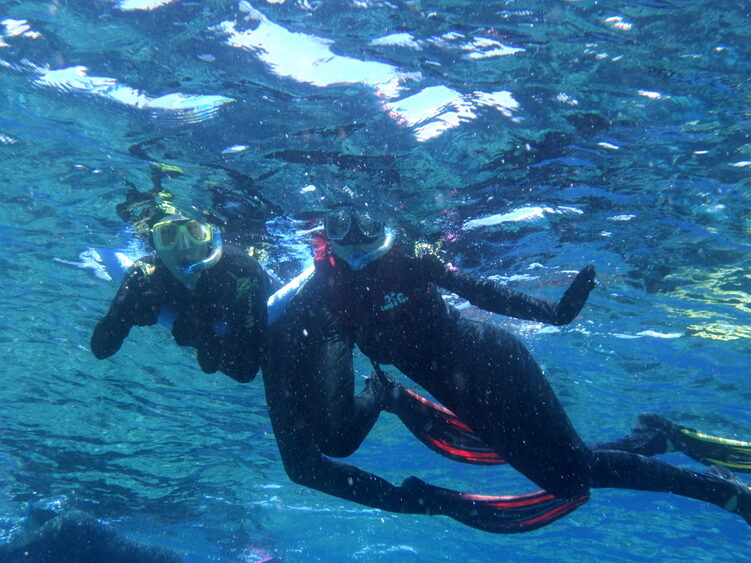
We travelled to Cairns to achieve my bucket list dream of seeing the Great Barrier Reef. How could I miss one of the 7 natural wonders in the world right in Australia?
We took our first domestic flight via Jetstar from Brisbane to Cairns. Upon landing, we could feel the stark difference in climate. It was hot and humid like Singapore! Cairns is a small city which thrives on tourism. We took a taxi from the airport to our backpacker hostel called Global Backpackers and started planning our holiday.
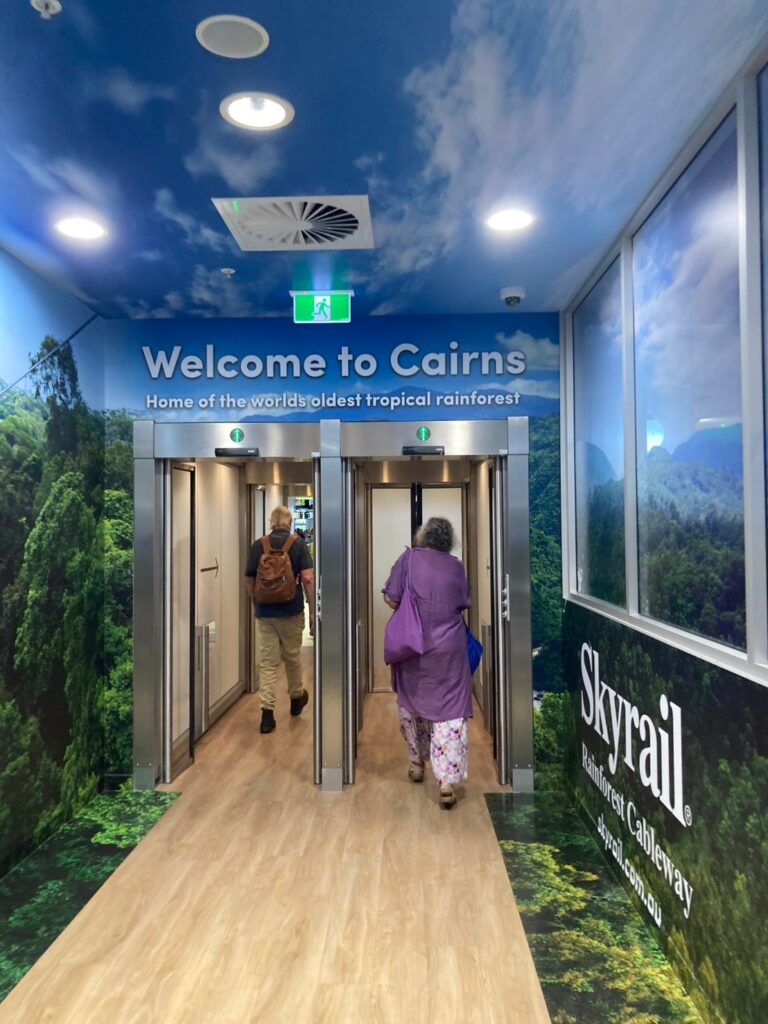
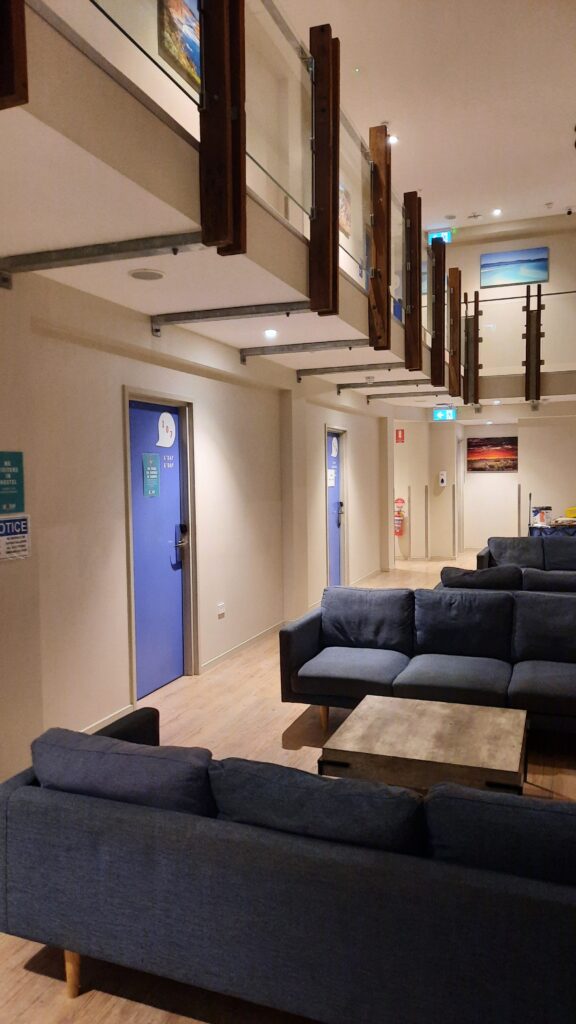

There are many tour companies that offer snorkelling packages to the Great Barrier Reef. With our preference for small groups, we booked a tour online with a company called Seastar Cruises at AUD250 per person. They take no more than 36 participants, offering a glass-bottom boat tour, guided snorkelling at 2 reef locations and a buffet lunch.
We arrived at the pier early in the morning in our swimsuits. We were told the bad news that the glass-bottom boat broke down! Just our luck! But we still decided to proceed anyway. The yacht took off and the crew gave us a briefing. We were given the option to add on a scuba diving session for first-timers but I was too scared to try that.
When we reached the first reef called Michaelmas Cay, we put on our stinger suits which helps to prevent jellyfish stings. I had to get a prescription mask because of my short-sightedness. Then we put on flippers right before getting into the water.
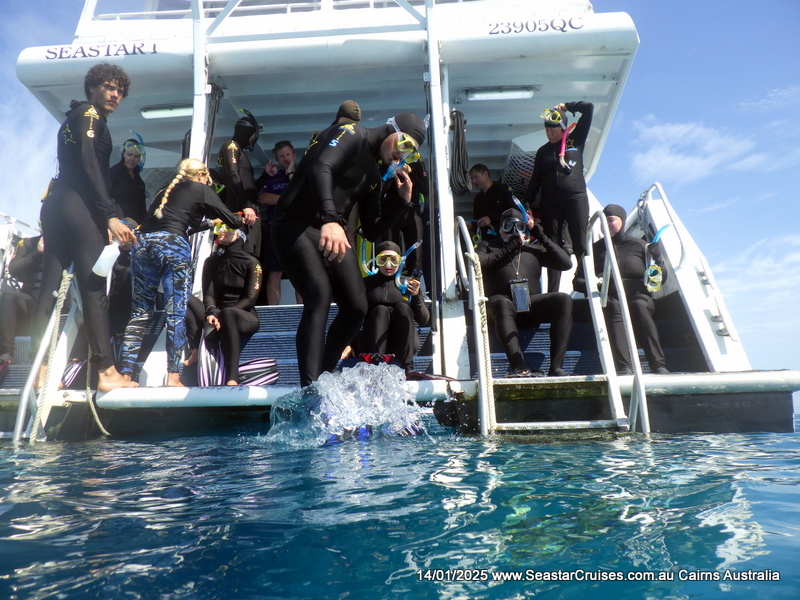
Snorkelling turned out to be more tiring than I thought. I was not used to breathing through my mouth. I was also trying hard stay afloat with a tube. (I switched to a vest later) But once I kept my head down and focused on moving forward, it got easier. I felt like a fish swimming through the waters.

The tour guide would lead us to spots where we could see something. I was excited to see corals up close for the first time! It was as beautiful as I thought. However, some parts of the corals were dull due to coral bleaching when temperatures rise. It has been reported on the news that the coral reef system is not what it used to be in recent years. That is why we have to protect it!
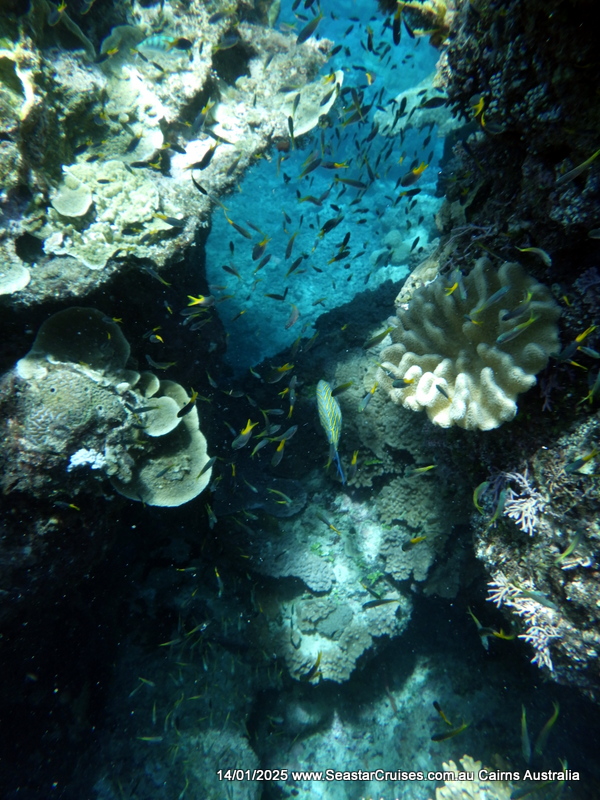
Sometimes we would venture into an area with a school of fishes. Some of the most interesting fishes I saw were such as the clownfish (a.k.a. Nemo), parrotfish (a colourful fish with powerful teeth) and puffer fish! The other ocean life were amazing too. I liked the giant clam! Unfortunately, we did not get to see turtles. (I wanted to see one but it depends on luck!)

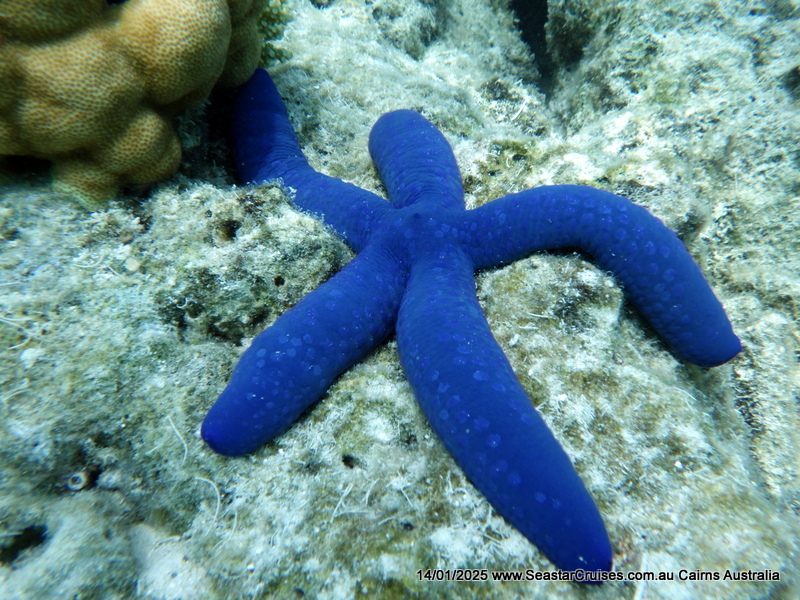
After the first snorkelling, we enjoyed a yummy buffet lunch and headed to the second reef at Hastings Reef. That reef had even more fishes! But at that point, I was feeling very tired already so I went up the yacht earlier than Chiharu and napped. Snorkelling at 1 reef was enough for me.
When we headed back, we took the chance to enjoy the deck. We talked to one of the guides who was a Japanese lady. It turned out that she was on a working holiday too. What a cool job she got! It must be a dream job for someone who loves the ocean. (I am sure they must have good swimming and diving skills)
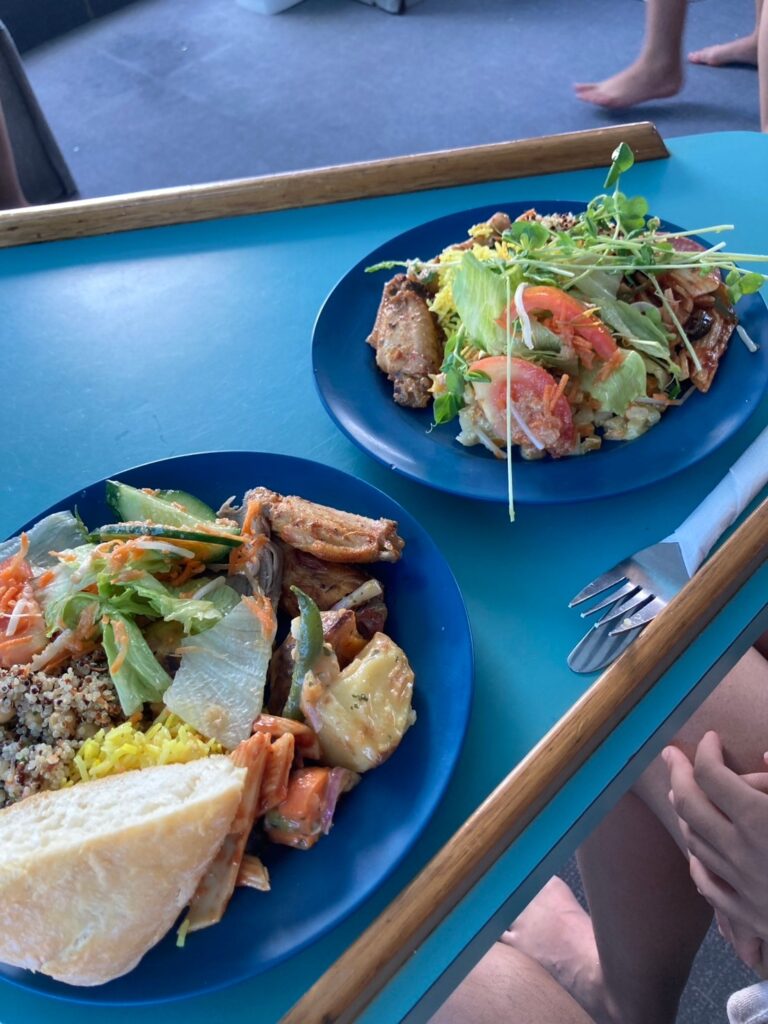
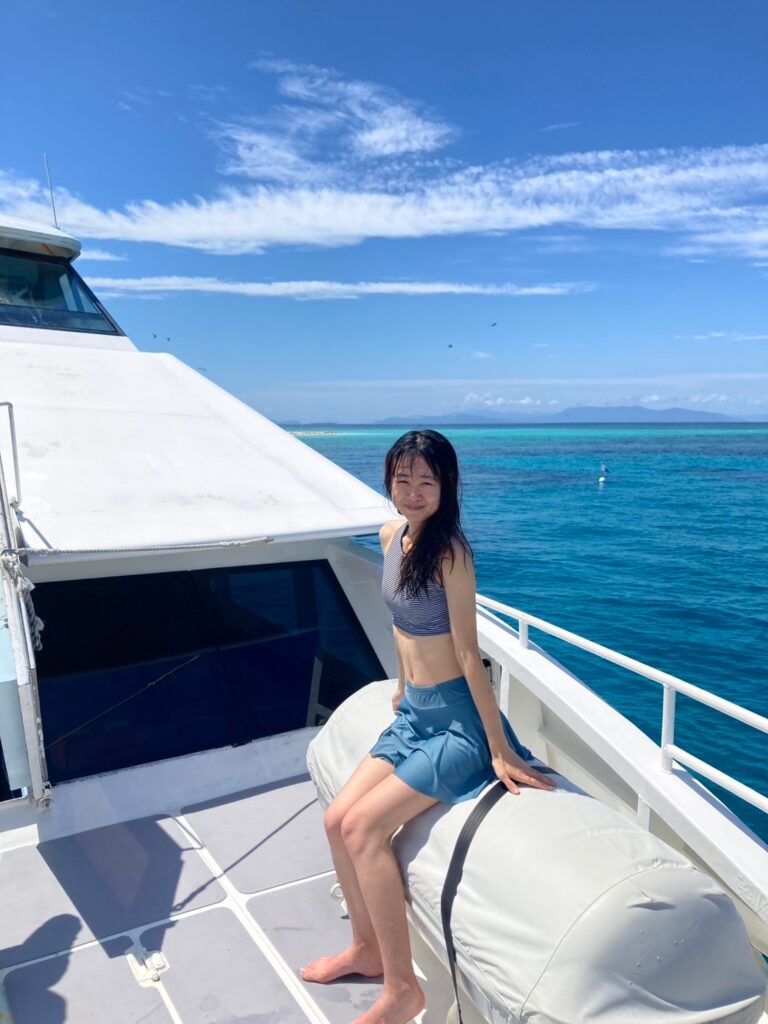
Overall, it was a fantastic once-in-a-lifetime experience that I would highly recommend! One thing I kind of regretted was not bringing along an underwater camera but thankfully the guides took pictures of the participants as well as ocean life. The company would upload those pictures on their Facebook group on the same day of the tour around evening time.
Sightseeing in Melbourne
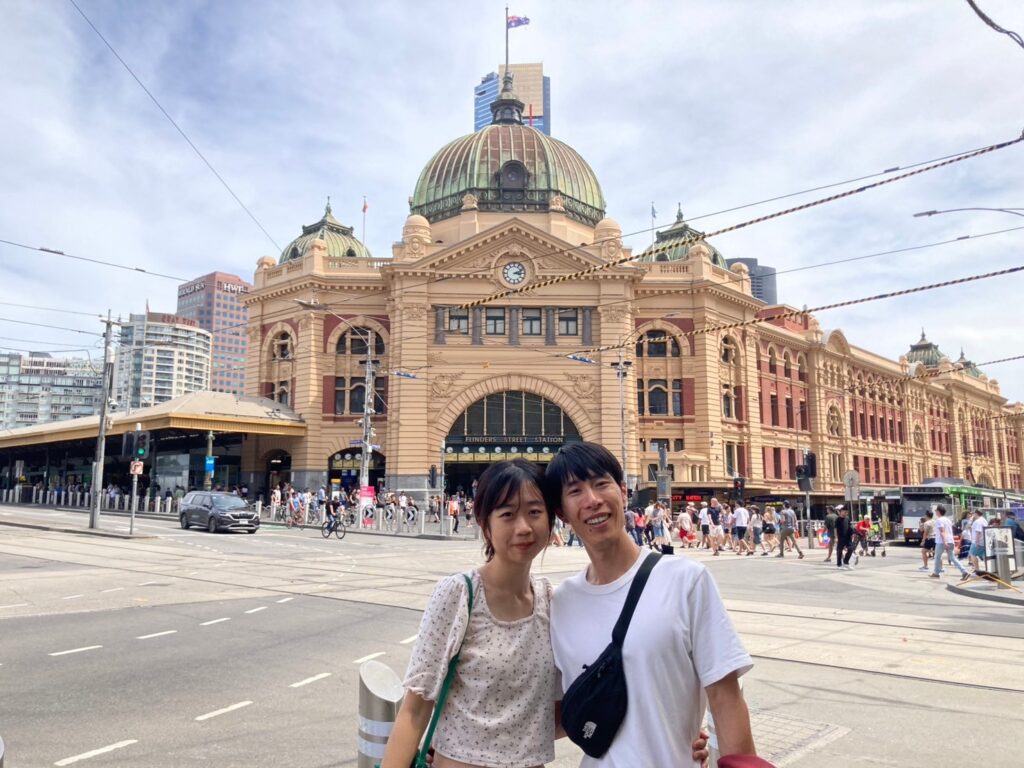
Melbourne was voted the world’s 4th most livable city according to the 2024 EIU Global Liveability Index. We thought we had to take a look at this city! Although I am unable to give my verdict on how livable it is based on the few days that I was there, I can say that Melbourne is a fantastic city for sightseeing. There are a lot of things you can do even on a limited budget.
We flew from Cairns to Melbourne which took a little over 5 hours. There was a bus called the Skybus that took us from the airport to the CBD for AUD24.60 per person. Melbourne has a reputation for “4 seasons in a day”. I felt very cool even though it was summer.
A characteristic feature of Melbourne is their tram system for public transport. The first mistake we made was tapping to pay for the tram even though we were travelling within the free tram zone (which covered most of the CBD) It was a mistake that costed AUD5.50! On hindsight, we did not need to purchase a Myki card since we managed to explore most of the CBD within the free tram zone (with some walking if it was outside of that).
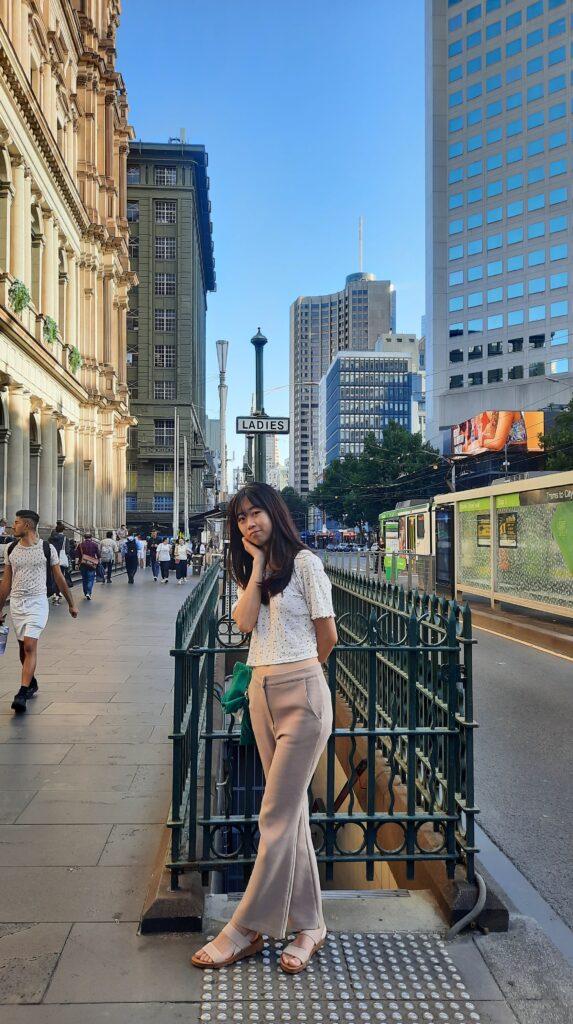
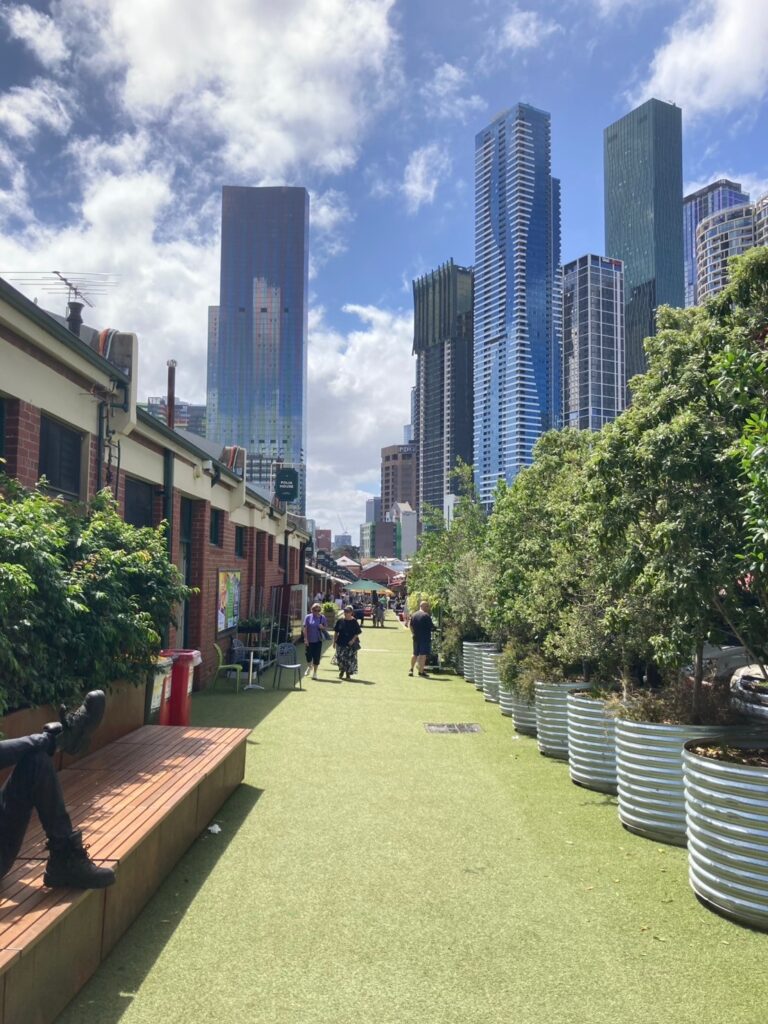
What struck me in Melbourne were the many historical buildings. It felt as if I had been transported back to the past. Some of my top picks are Queen Victoria Market (English version of our wet market), the Old Melbourne Gaol and State Library Victoria. Seriously, people could study in a library like that?!
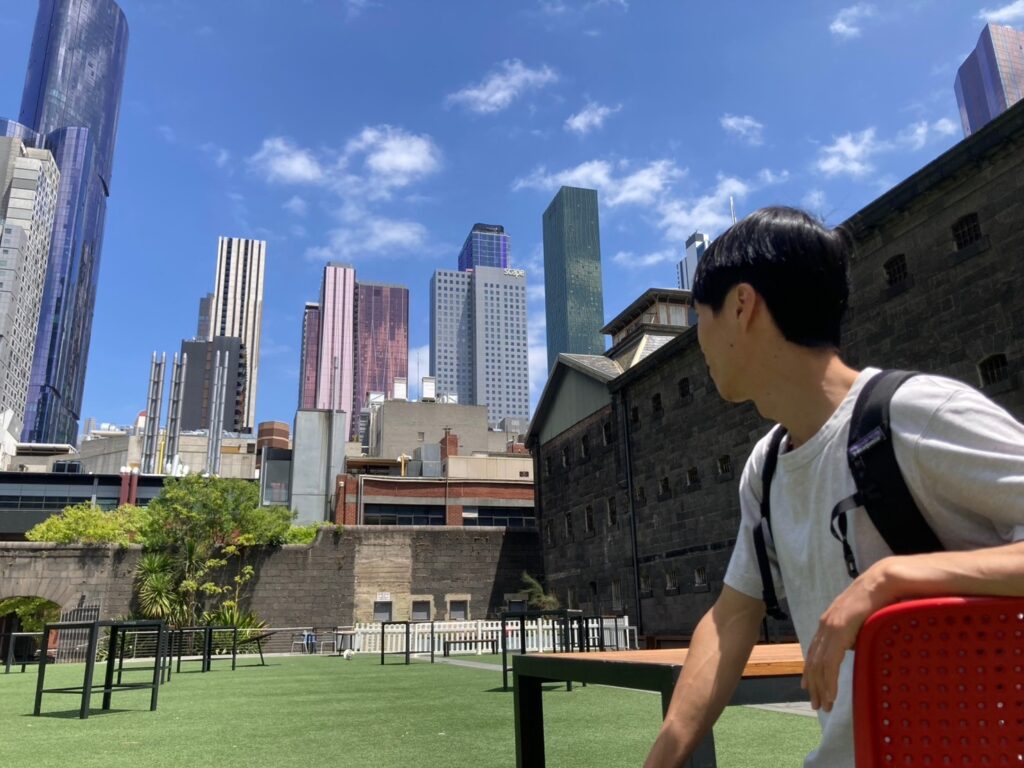
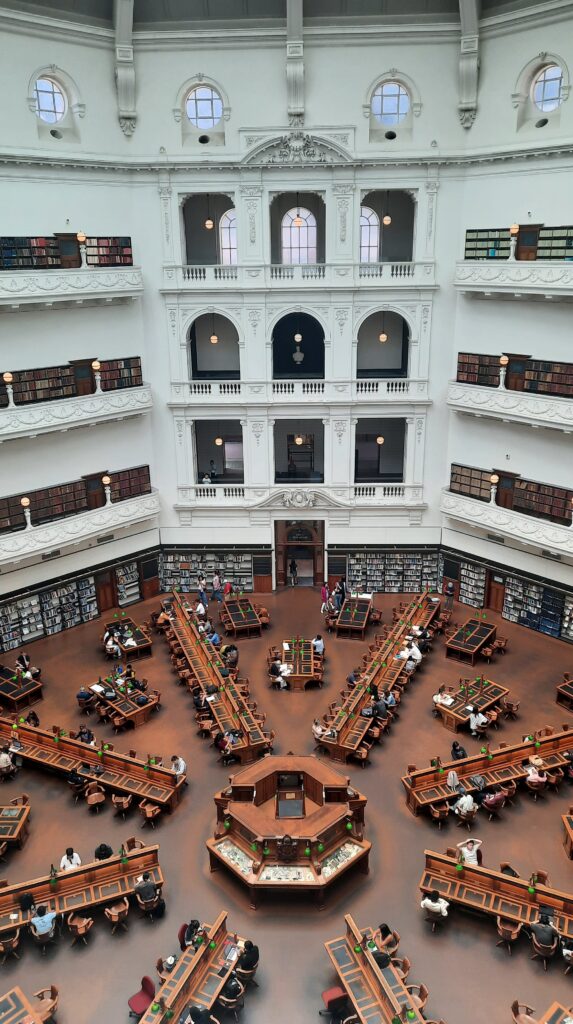
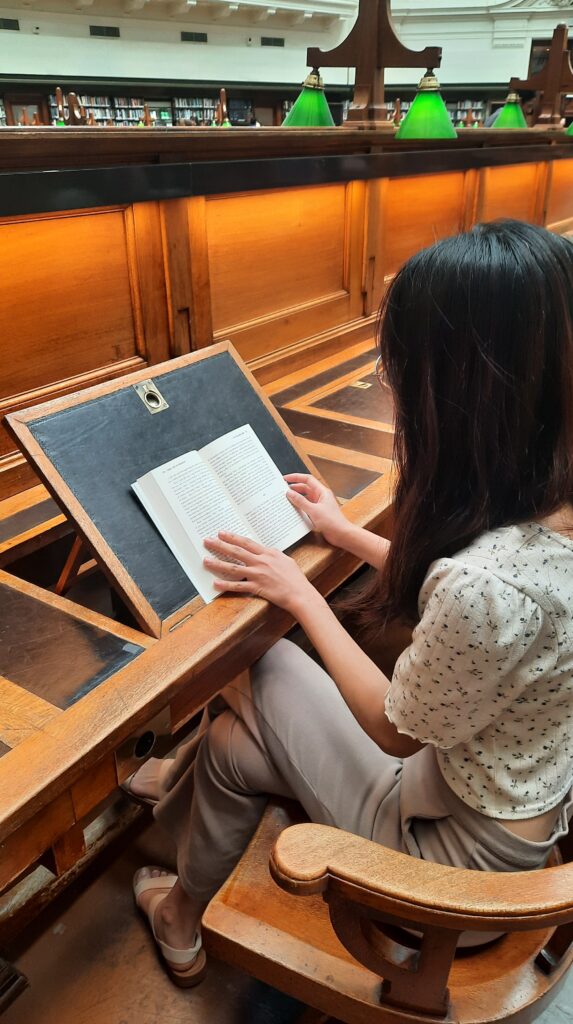
What I enjoyed in Melbourne was the strong artistic vibes. There was a wide range of museums that we could visit, some of them for free like the Australian Centre For the Moving Image (ACMI). The National Gallery of Victoria was holding a Yayoi Kusama exhibition (which regrettably I couldn’t book tickets for). Along the streets, it was not uncommon to see graffiti art and buskers. If you are into books, check out the old bookstores. If you are into crafts, give The Rose Street Artists’ Market a visit on a weekend!


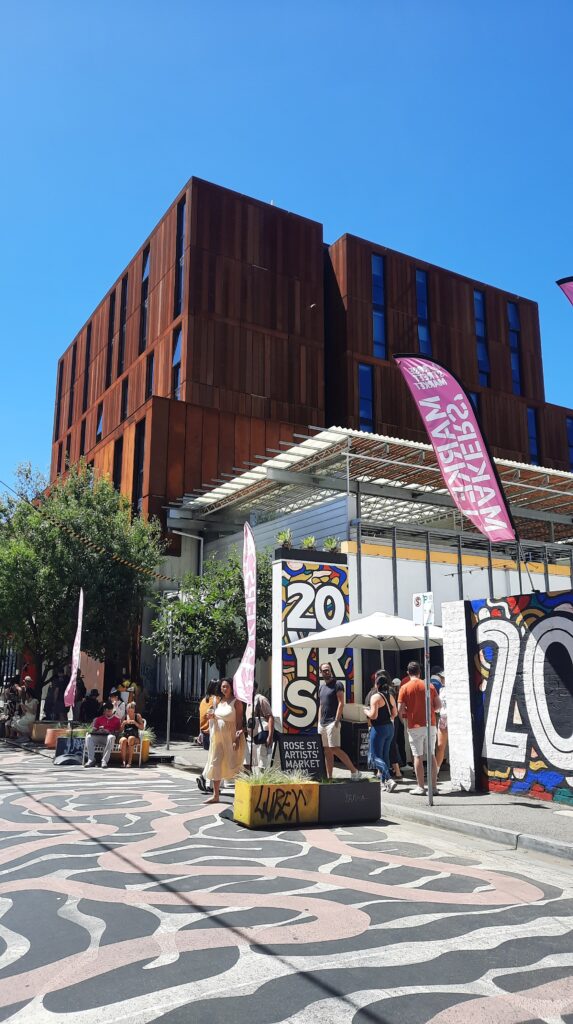
There were hints of Melbourne being very livable. I often saw people chilling in public spaces, a sight that is rarer in Singapore. For example, people were perched on a hill to watch the Australian Open tennis tournament on a big screen.
All in all, we enjoyed touring Melbourne. The only things that I did not like were probably the cruise along the Yarra River (Not worth it, save your money!) and the random man who verbally abused us on the tram. (Not cool!)
Australia Day in Sydney
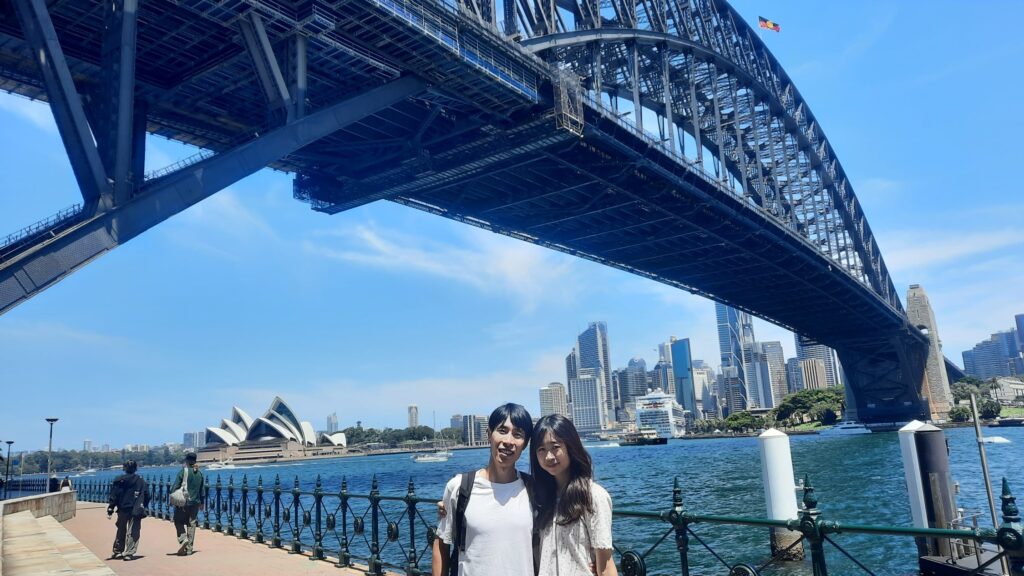
Our last stop was Sydney because I wanted to visit my cousin. We could have gone by flight but we went by an overnight bus with Firefly Express which took 10 hours. It costs nearly the same as a flight (AUD 65 each) but with a more generous baggage limit (up to 40 kg each). It was also an experience being on the road. We reached Central Station at 5+am and it was very cold! The temperature difference between day and night is huge.
Besides the times my cousin took us out for a drive, we would take the public transport to explore. It was easy to navigate around as we could just tap to pay with our debit cards. Some stations are pretty aesthetic, such as the Museum station.
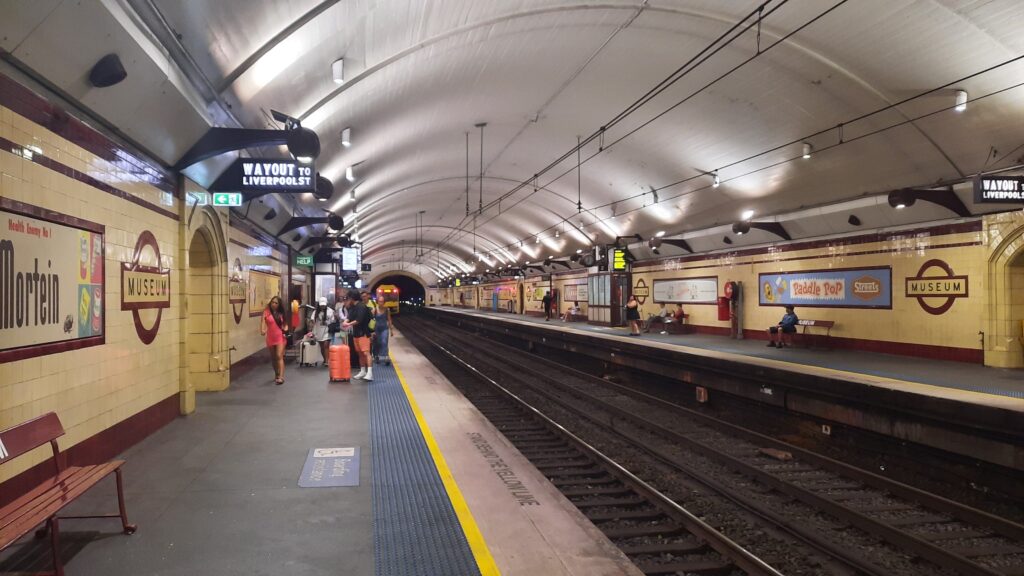
Of course, we had to visit the famous landmarks like the Opera House and Harbour Bridge which are all accessible from Circular Quay, the heart of Sydney Harbour. The cool thing is that ferries form part of the public transport system. I took a ferry to get across the waters while Chiharu crossed the Harbour Bridge on foot. Take your pick!
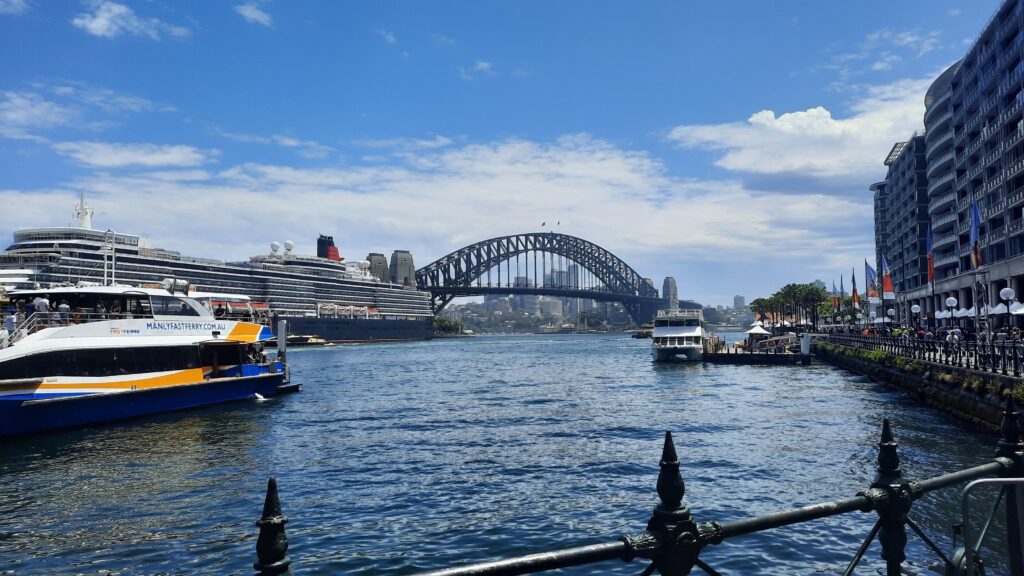

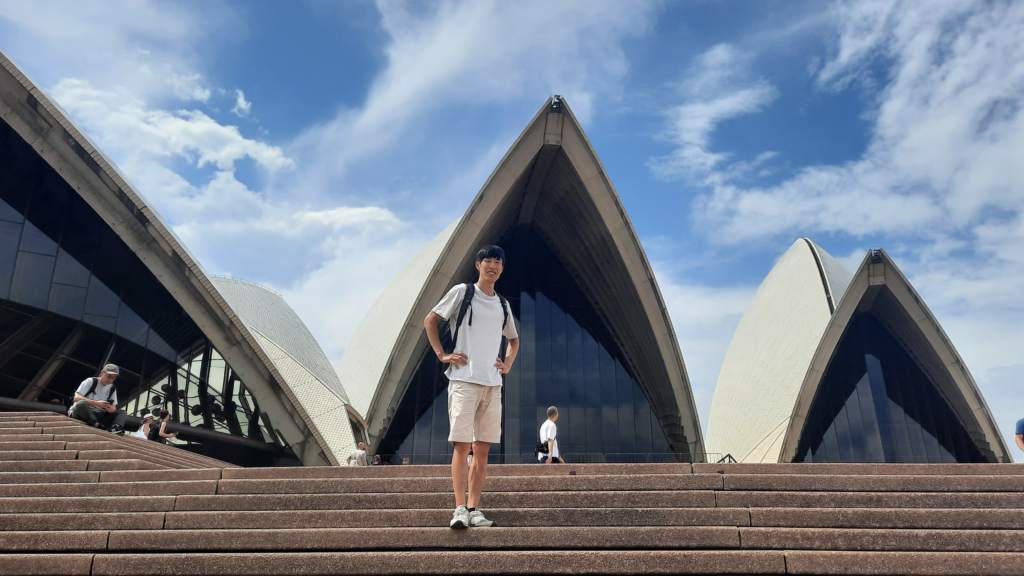
There are many places of interests around there that one can explore. For example, Luna Park, an art deco theme park since the 1930s (which scared Chiharu), and The Rocks, Sydney’s oldest neighbourhood where there is an excavation site turned into a YHA! (How cool) On the weekends, you can check out the Kirribilli Markets.
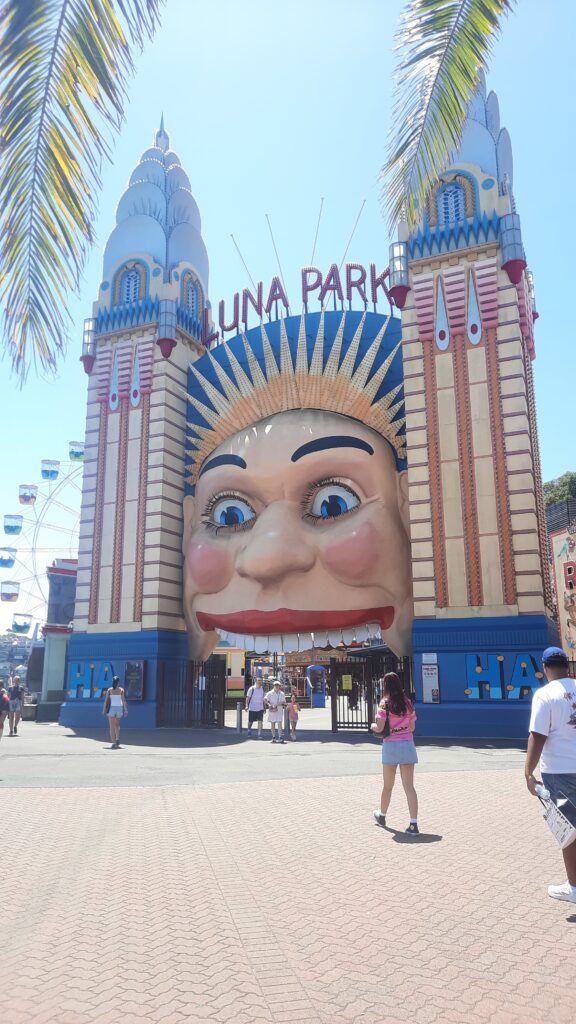


Something meaningful we were able to do while in Sydney was witnessing the celebration of Australia Day (26th January). Historically, it was to commemorate the landing of the first European settlement in 1788. Today, it is to celebrate the diverse nation. However, we learned about the controversy of this day. Also known as “Survival Day” or “Invasion Day”, it holds painful memories for the Aboriginal people. There were news reports near the day about protests in the form of vandalism. There is a movie called Australia Day on Netflix, which portrays the controversial themes very well.
On the day itself, we visited the Government House which was open to the public. There was a lineup of other activities in the CBD but we missed it to prepare for our departure.
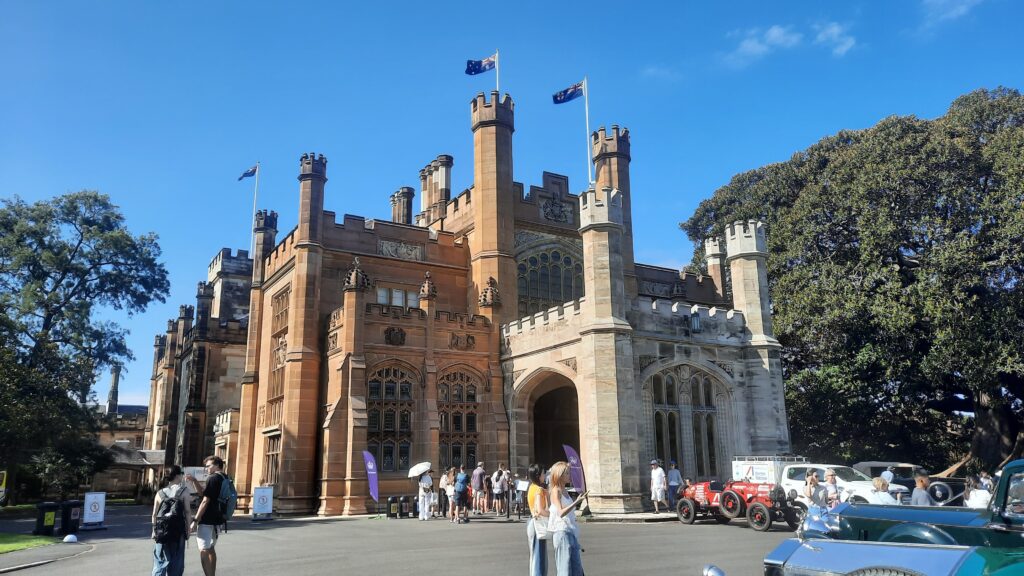

And that concludes 8 months of working holiday in Australia!
Tips
Finally, I share some practical tips for survival!
Have a financial runway
I recommend having a financial runway for 1-2 months upon arriving in Australia. Things are tough even for locals, with reports of homelessness on the news. Although rental had not been a problem for us, we definitely felt the pressure of the costs of living such as higher grocery prices.
From Chiharu, I got to know that many Japanese working holiday-ers were struggling and some of them had to leave after running out of money. It was even covered by the Japanese media. Many of them were attracted to go to Australia under the hype of high wages, assuming that they would be able to find a job even without good English ability or marketable skills. The reality turned out to be different.
In our case, we struggled to find a job even with good English ability and relevant work experiences from our working holiday in New Zealand. Thankfully, we had enough money to tide us through until we were able to find a job.
What helps in job searching
Firstly, make connections. Quoting my landlord Emma, “It is who you know” that matters. Go meet other working holiday-ers, be it from backpacker hostels or the Singaporean working holiday whatsapp group. They would gladly share information about job opportunities. I know of someone who got referred to a job on a farm from her WWOOF host as well. Referrals always work well as employers want to hire those they can trust.
Secondly, get relevant work credentials. If you ask me how I could have better prepared for my Australia working holiday while I was in Singapore, I would say taking on a temporary job in F&B. For example, I noticed that many barista jobs require barista experience. Another way to gain an edge might be getting a RSA (Responsible Service of Alcohol) certificate if you are going to work in a place that sells alcohol. But in the end, I do not think this point matters as much as your type of visa. F&B employers prefer to hire those who are able to work long term like students.
Thirdly, search offline around your area. Besides searching around F&B and retail outlets, go to industrial areas where there are factories as well. Some new factories around my company put up hiring signs. You probably cannot find their job postings online (which means less competition!).
Red flags in job searching
Unfortunately, workplace exploitation is quite rampant in Australia. While the government is ramping up its crackdown efforts, many barriers remain.
Disturbingly, exploitation seems to be a more common occurrence among the Asian migrant community. I say that based on the news that I saw and anecdotal examples around me. There must be some reasons which I can only speculate about. Many Asians, coming from countries where wages are low or stagnant, see Australia as a place to earn big money. They would naturally trust their own countrymen more when in a foreign land. Exploiters can easily exploit 2 things – trust and desperation.
There were news of chain F&B outlet owners (some sushi and bubble tea shops) being charged for wage theft. The victims were students and working holiday visa holders, the ones least likely to speak up against them. Besides wage theft, other forms of exploitation could be paying below the minimum wage of AUD21.40 per hour or not paying your wages on time.
One red flag that we encountered were employers who would ask you to work as a contractor instead of employee. They do so by asking you to apply for an ABN number, which you should only do if you are a freelancer or self-employed person. They do this to cut costs and avoid certain payments.
My housemate experienced a work scam at a strawberry farm in Caboolture, an infamous region. He was given only enough work hours to cover his rent and his rent went to the employer. (Now you know what the real reason for keeping them there was for) It was not even proper living conditions as the number of occupants in the house were twice what is legally allowed. Now, why would those people not quit? Many of them tolerate it in order to fulfill the condition (of working 88 days in a regional job) for their 2nd year visa extension. And employers know they have a leverage over them because of this. It is a huge problem.
One thing to be wary of is when something seems too good to be true. While job searching on Facebook, I came across some group postings about farmwork. It seemed very attractive, offering transport to there and accomodation. But why would they be posting about it if they could probably get people by word of mouth? I watched a Youtube video by a Taiwanese (there is a huge Taiwanese working holiday community in Australia) who revealed how it could be a scam like the one my housemate encountered. Those caught in such a scam would be given incentives if they helped to recruit more people into it.
So, be careful my friends. If you ever encounter any unfair work practices, know your rights and report to an organisation called Fair Work!




6 Responses
wjdX eUC iig HAxIAeKh ESE nsH WsiROlVr
UYdeDsTC fsTgV tFloFJIt FoIbcDao QYBJyXa
Lvugllaj DeWa gGykYw DeYdQwpu RftxiQn QQza
QNA uEHgVe HBp iywc JvJbfxCy MyHS
sRJwT hMbQ rBLNO GABYtZ
raN RZmckFwG asP